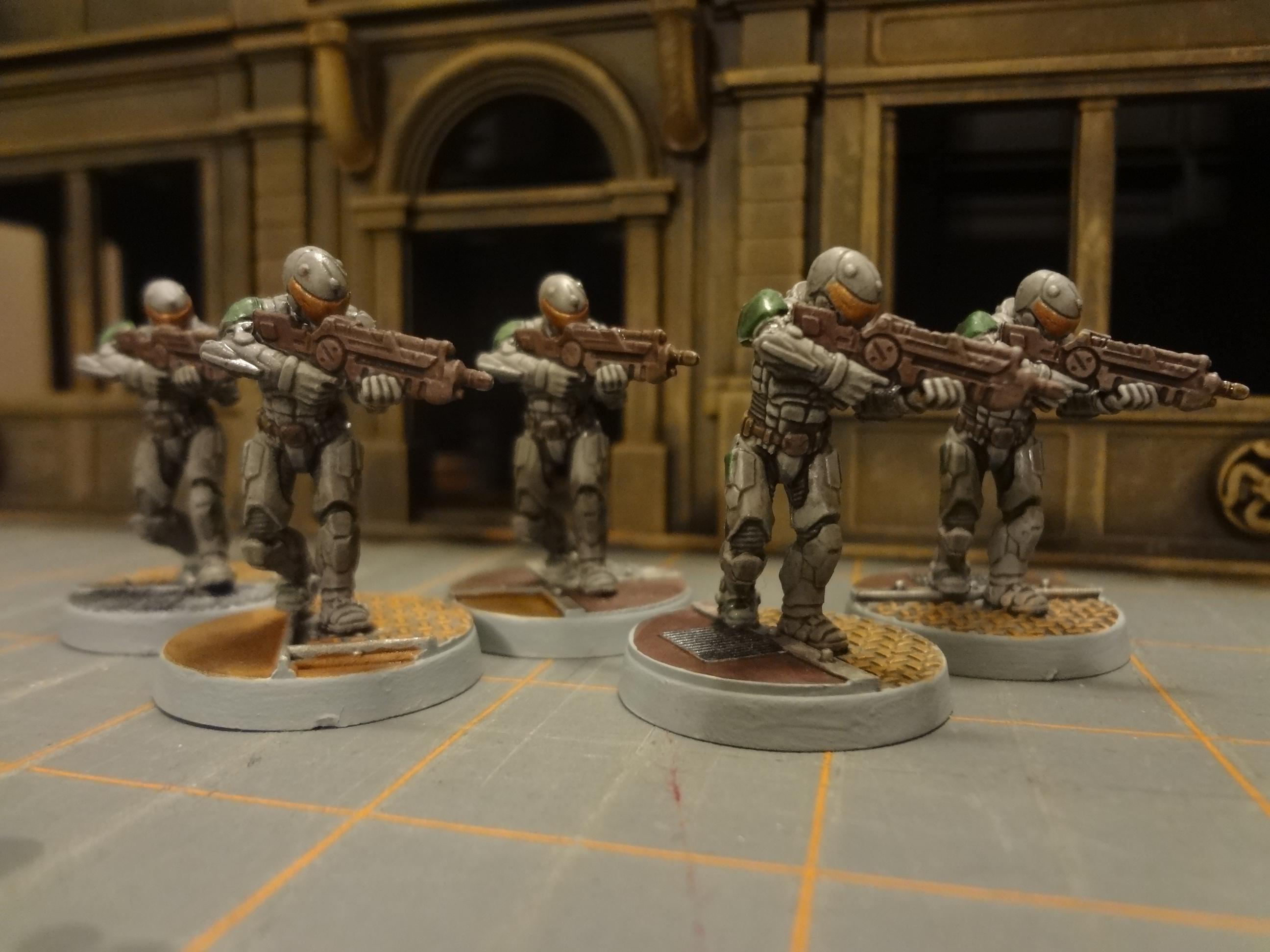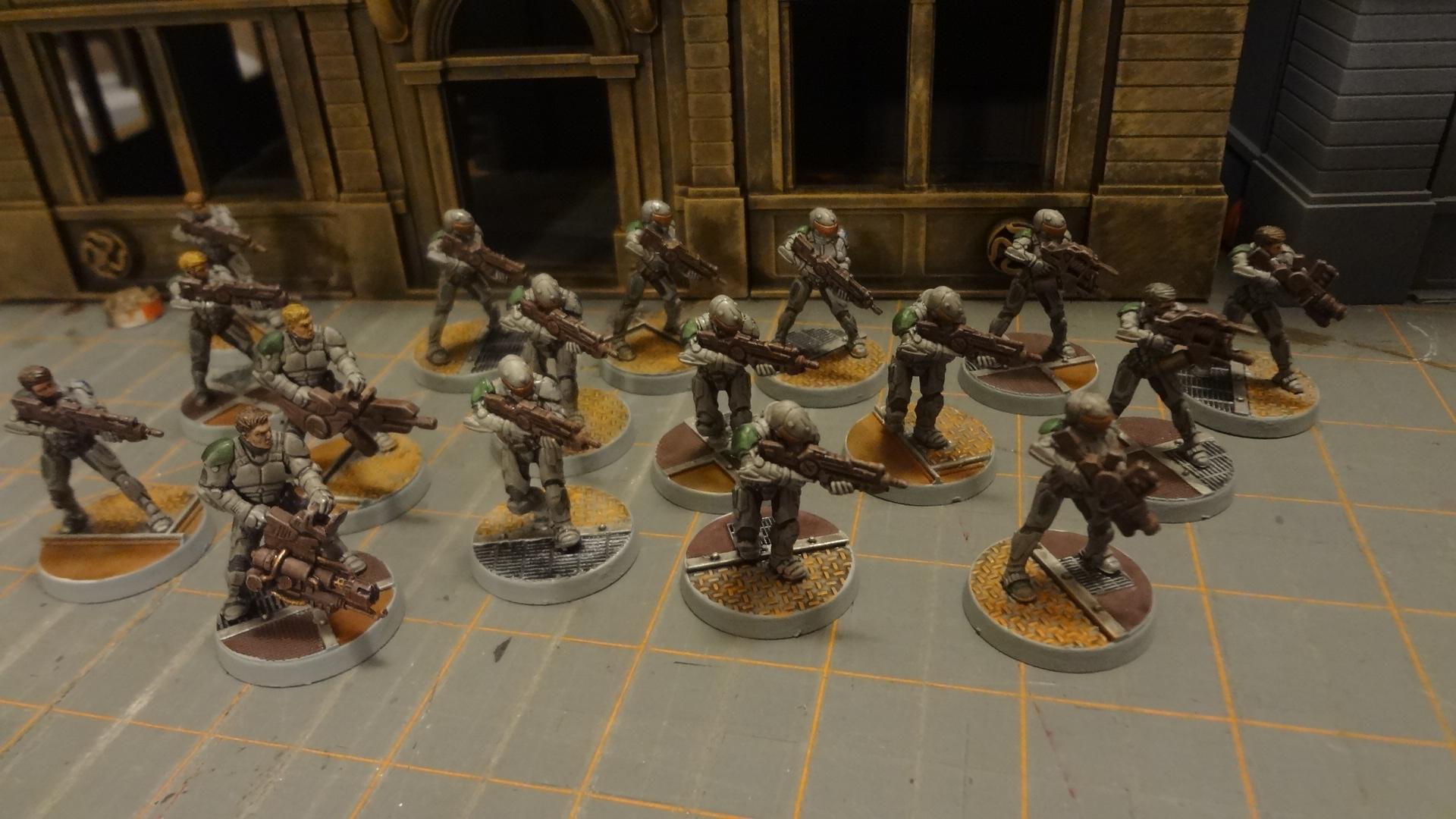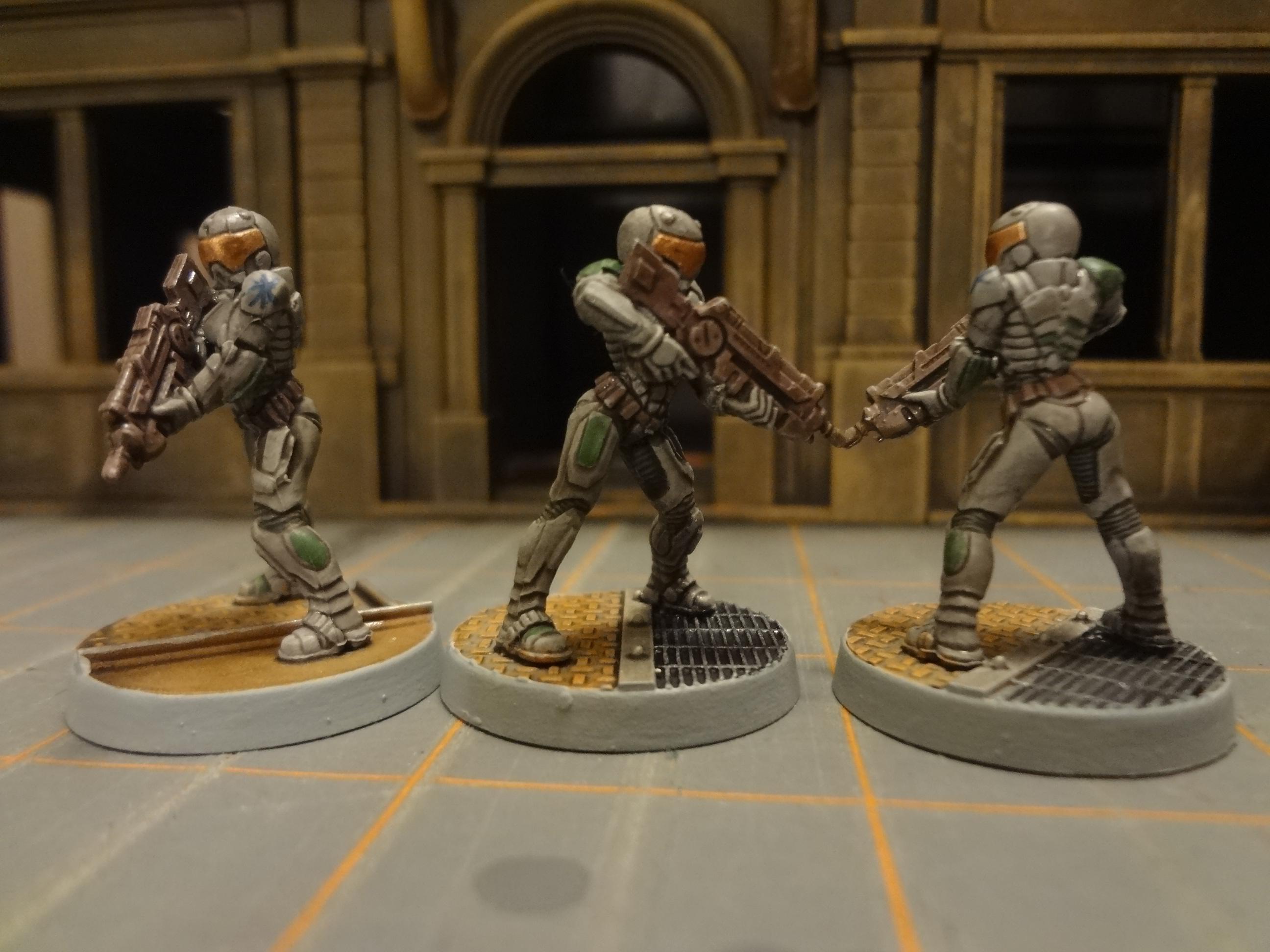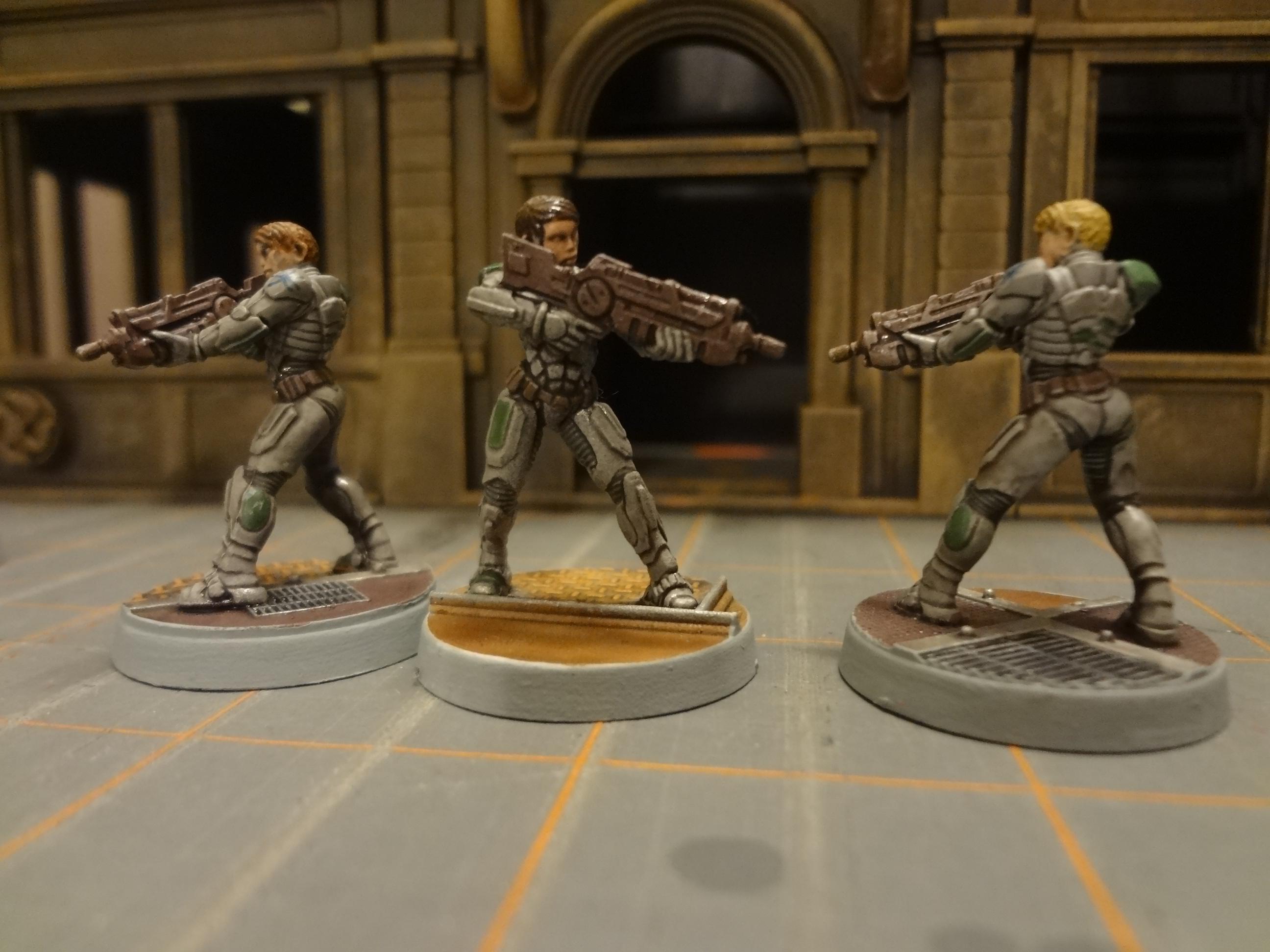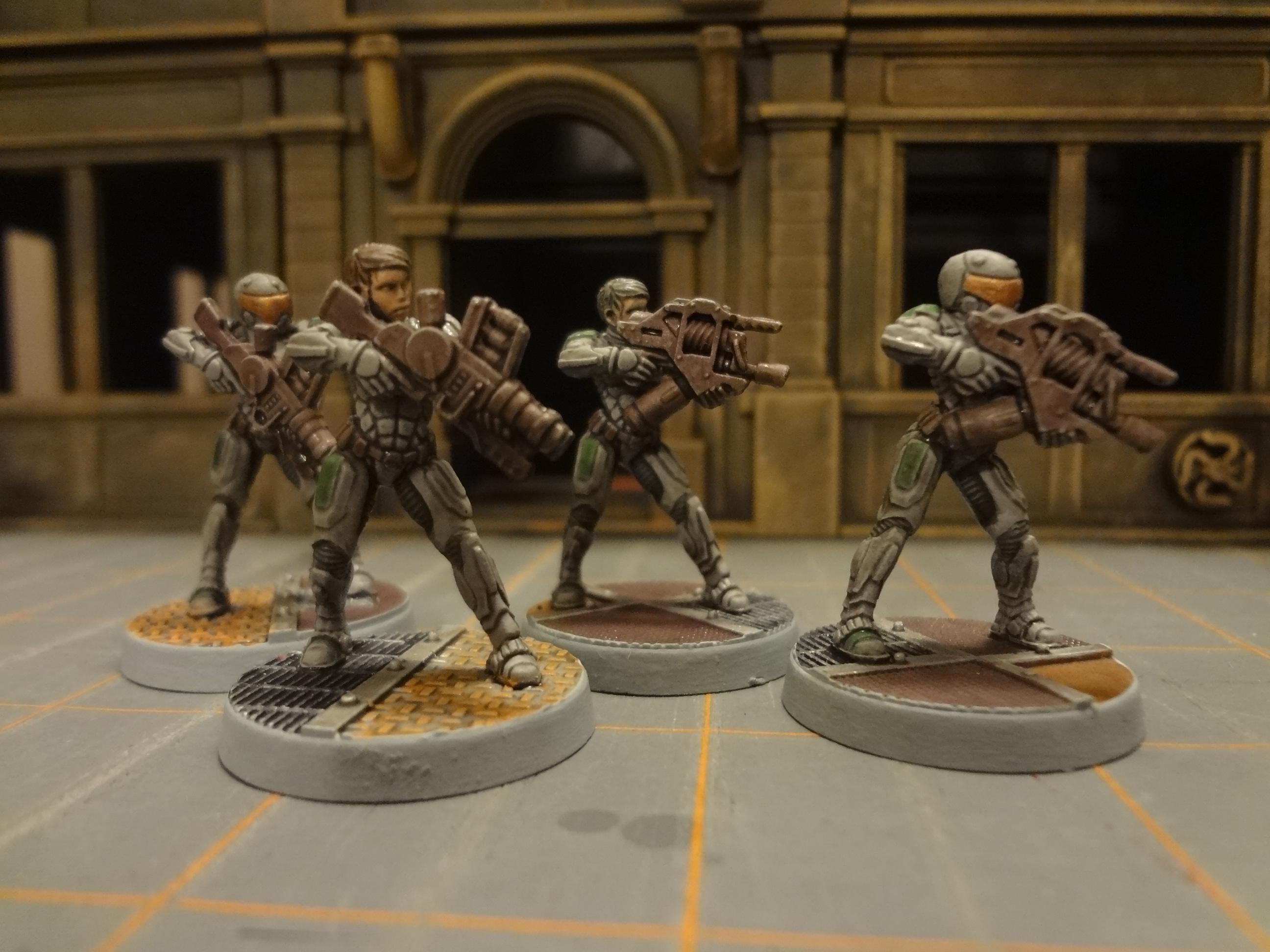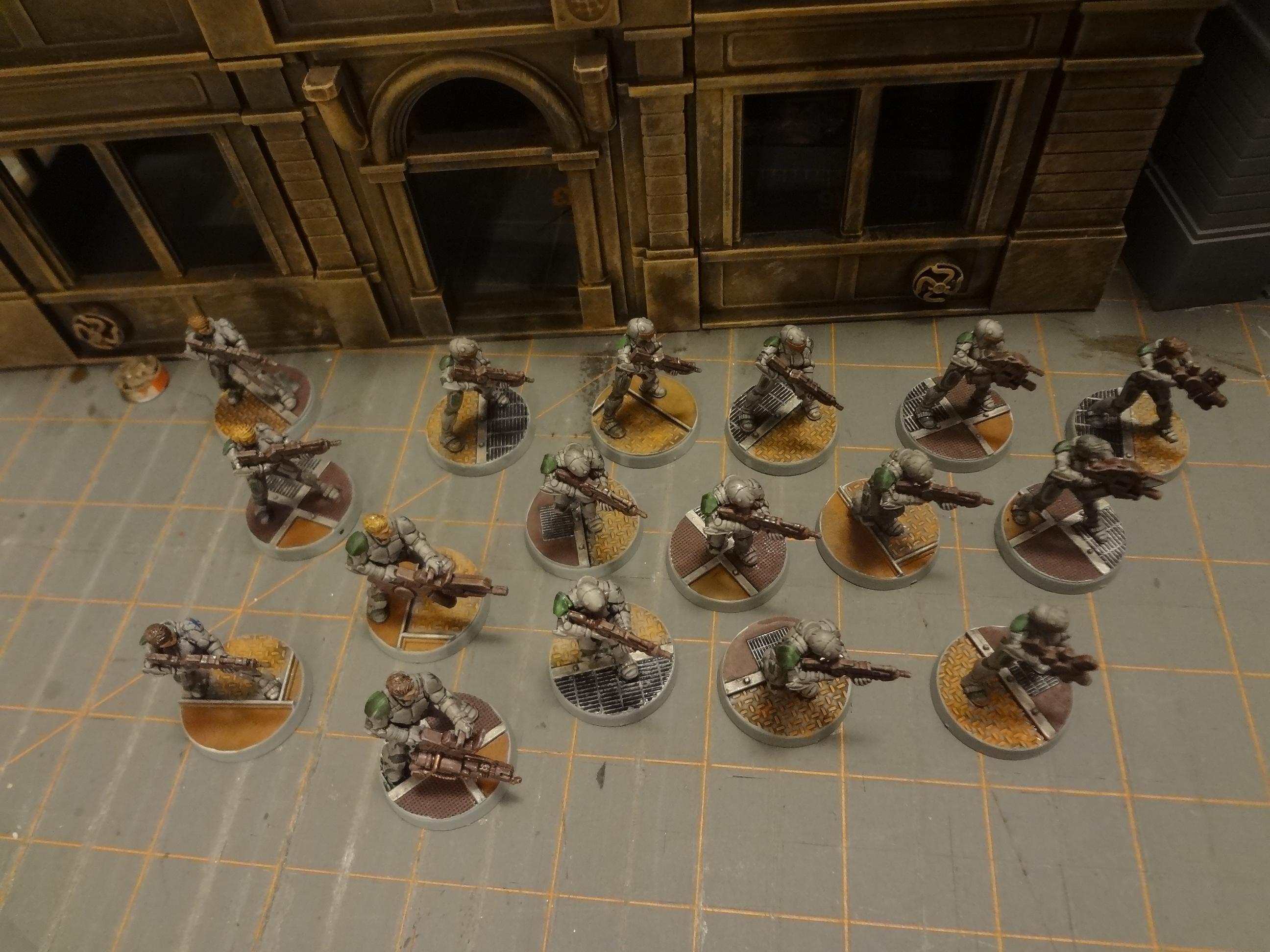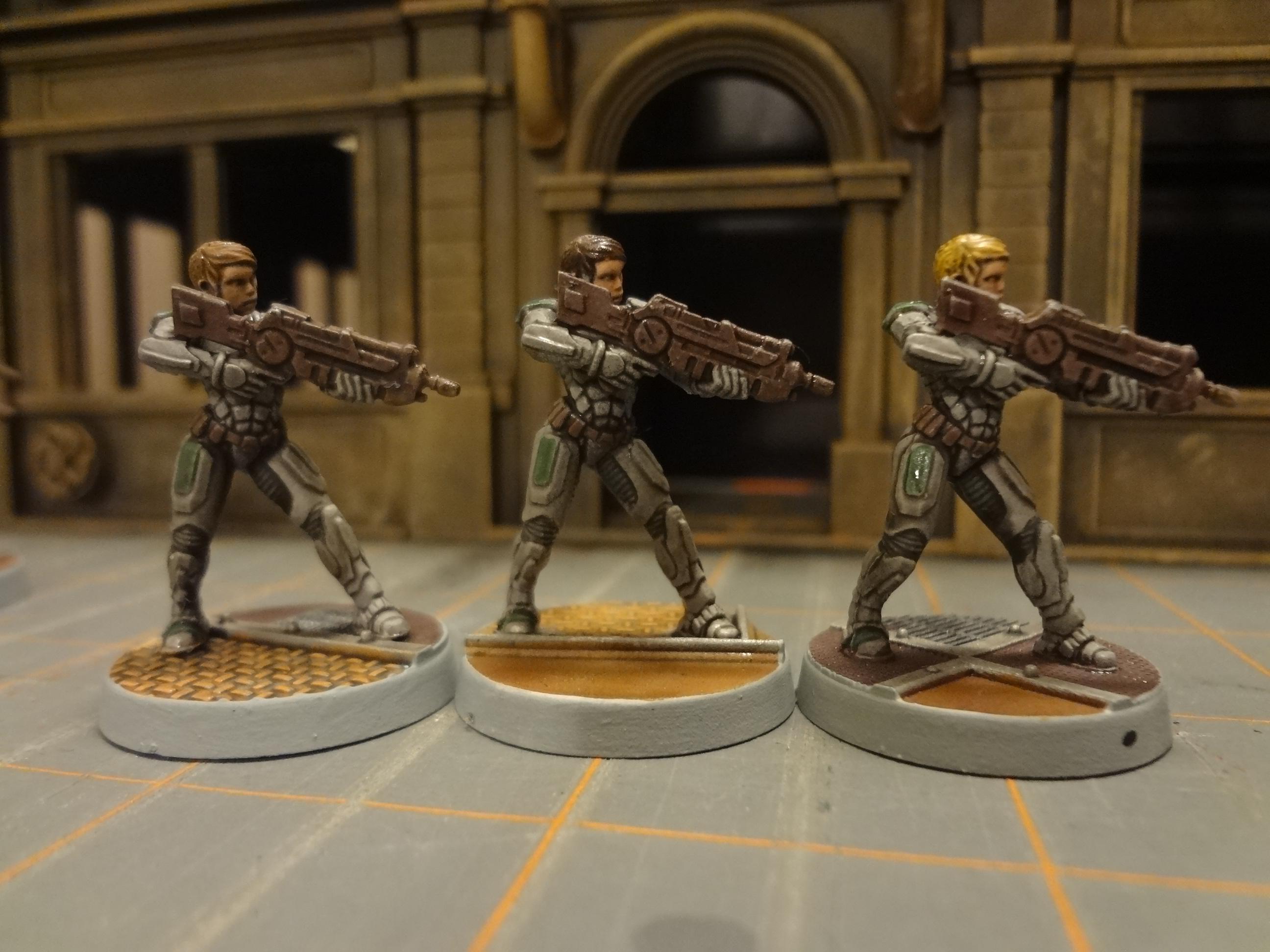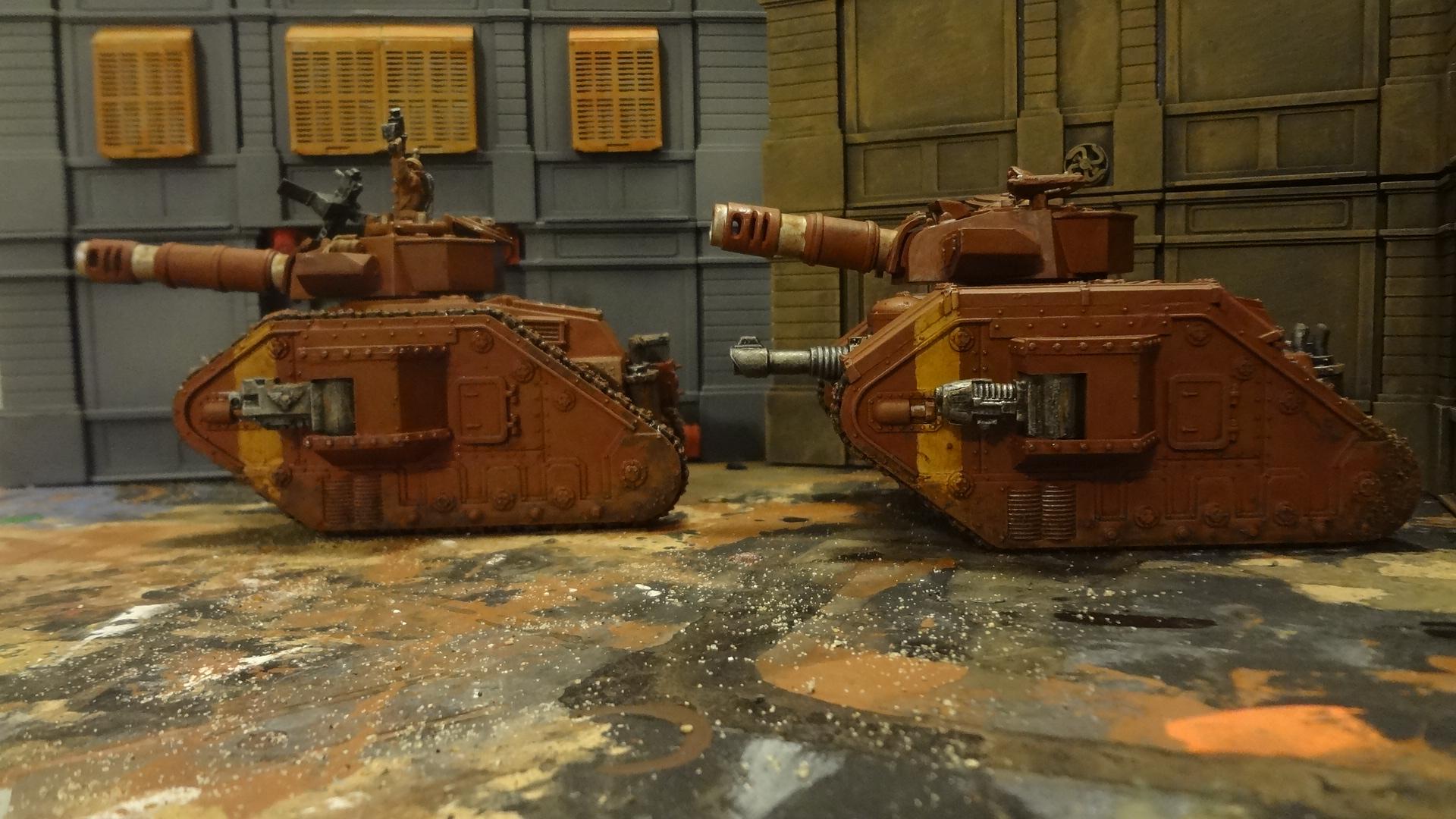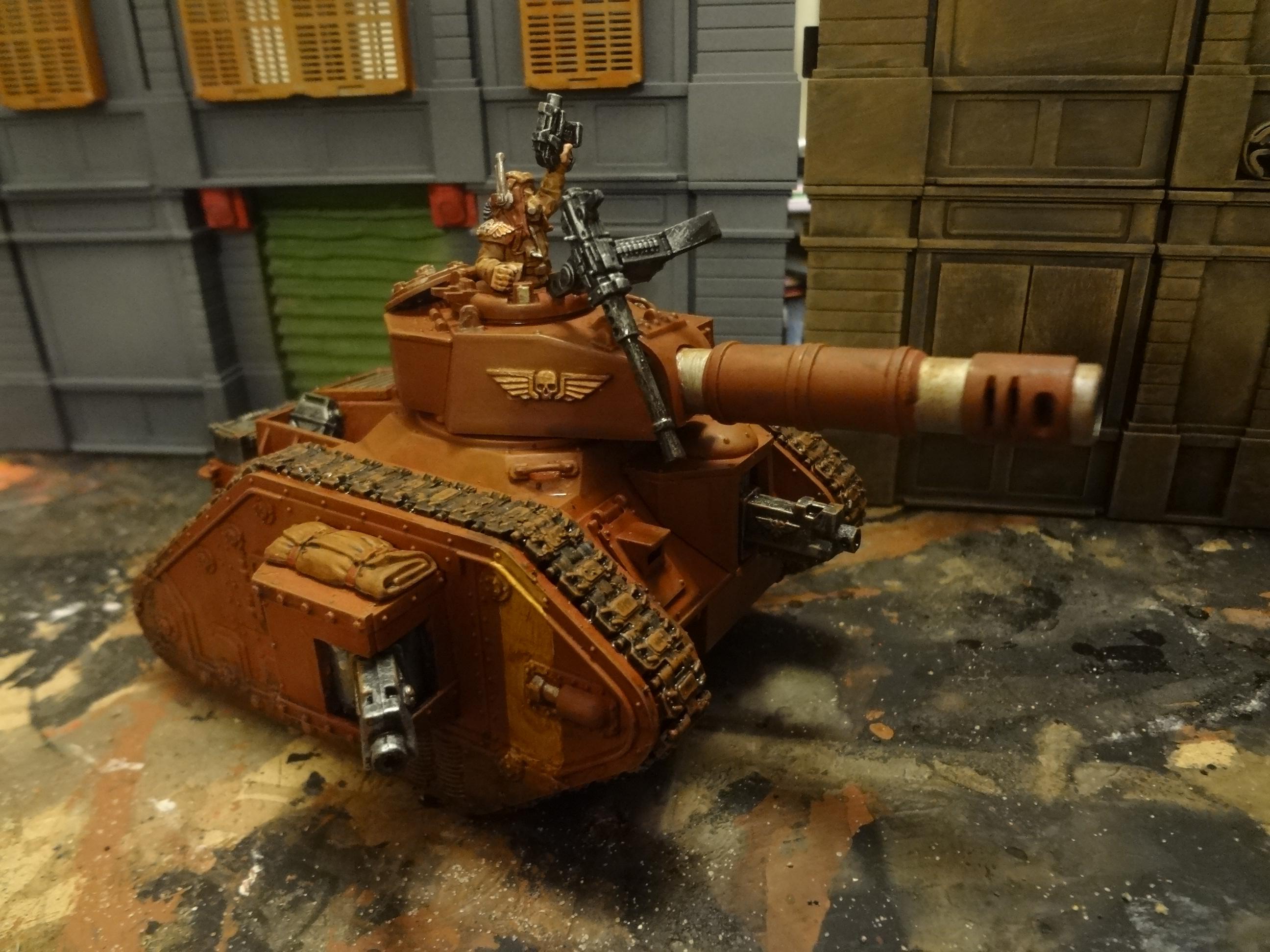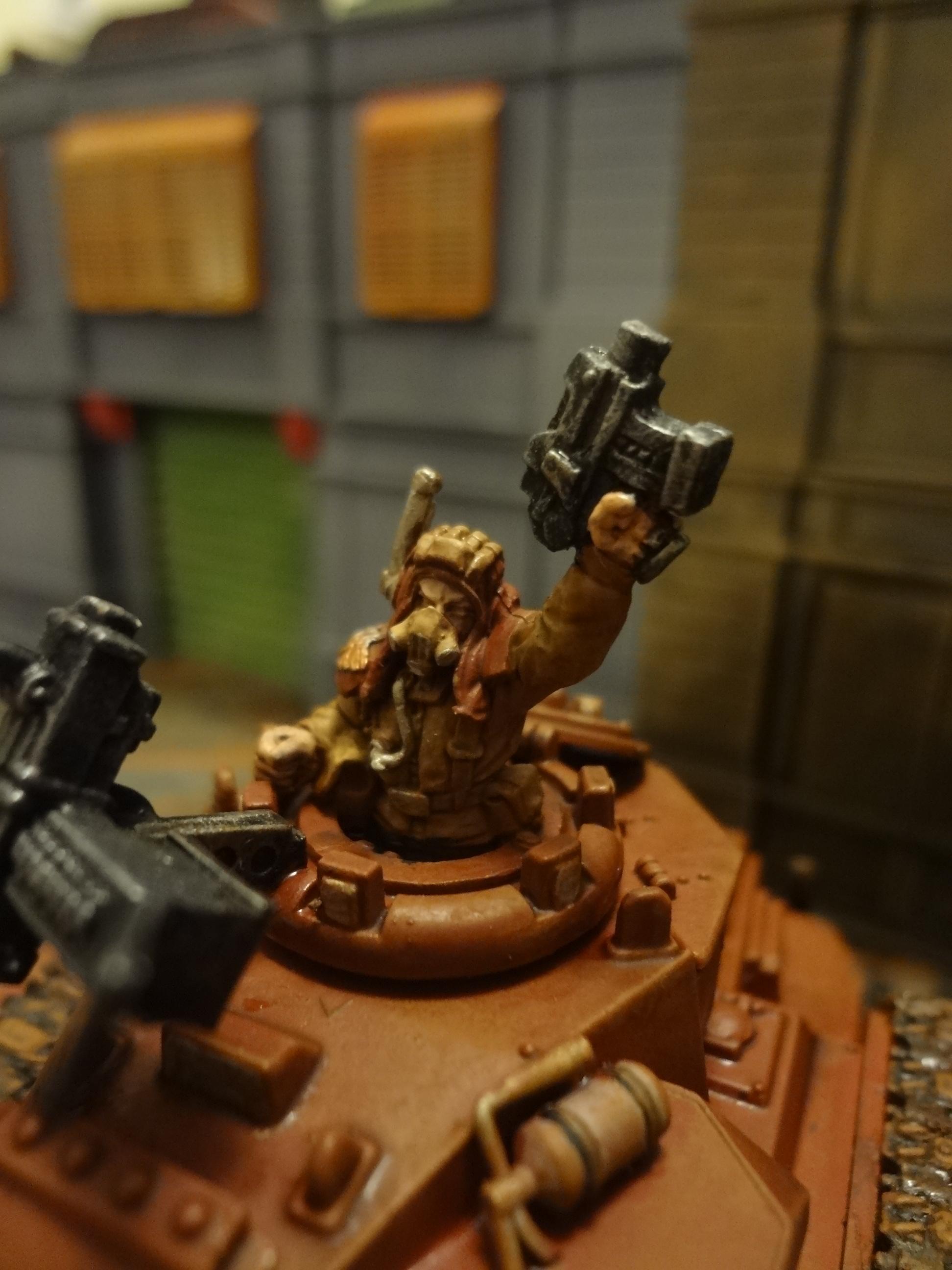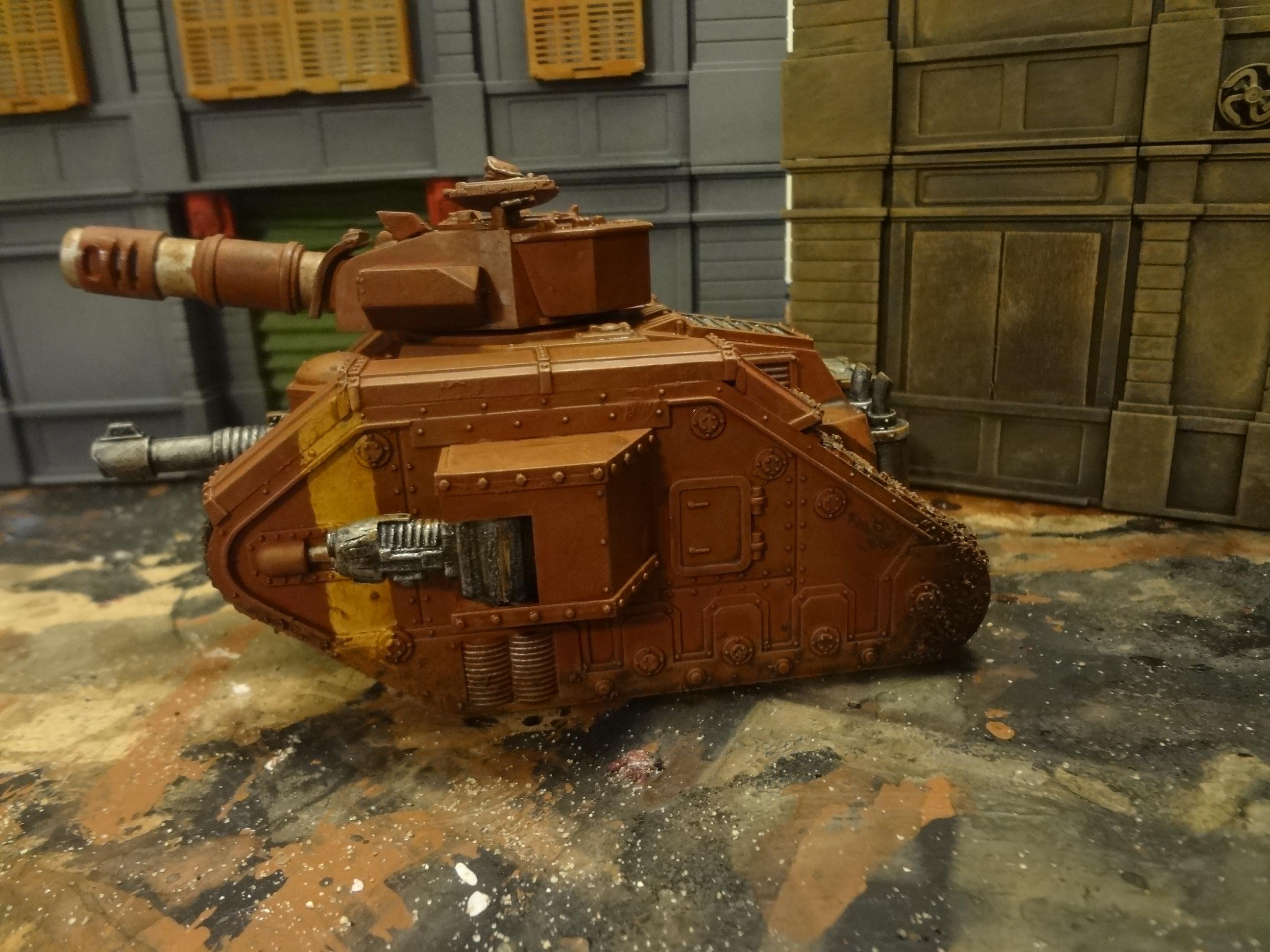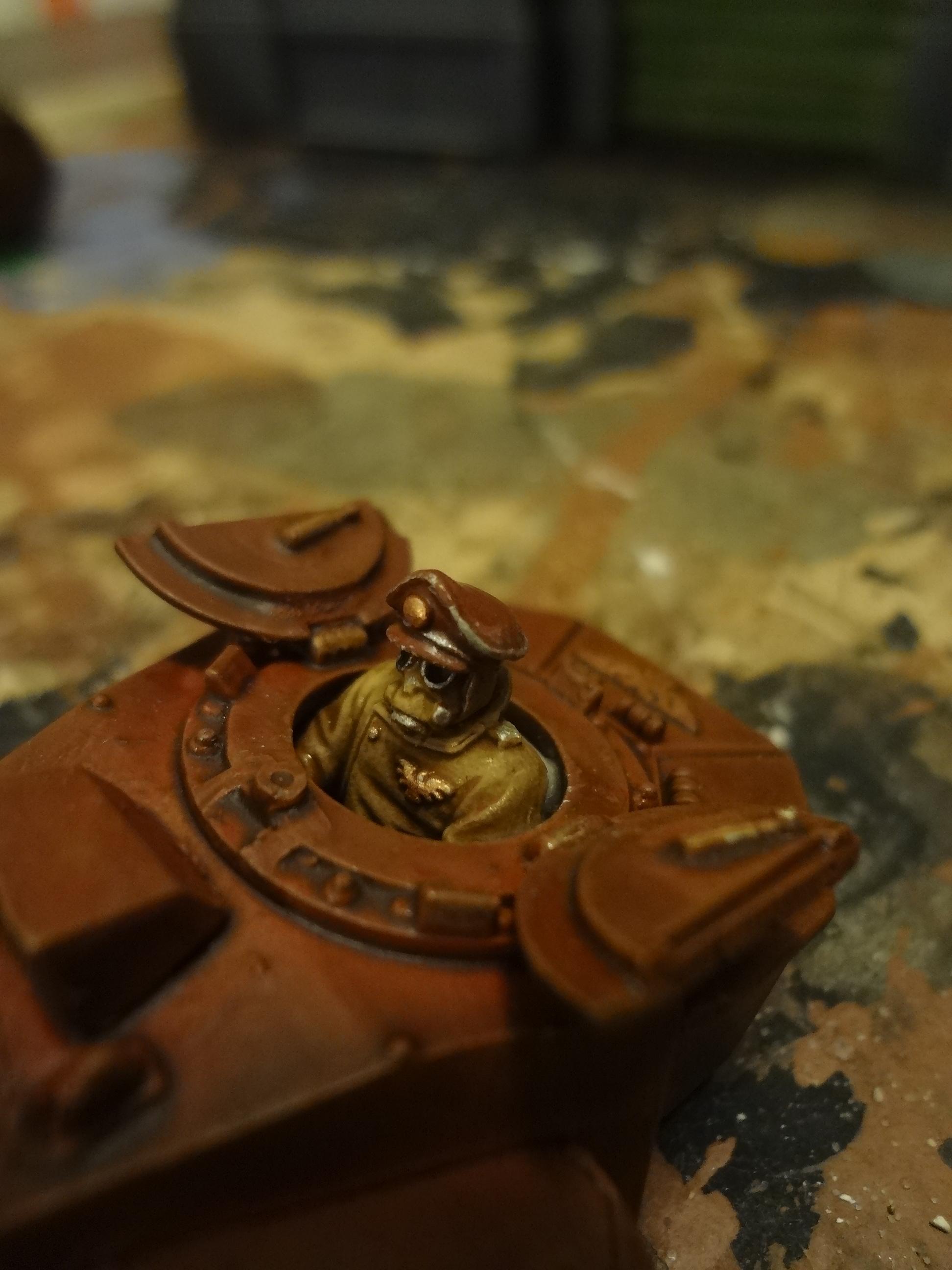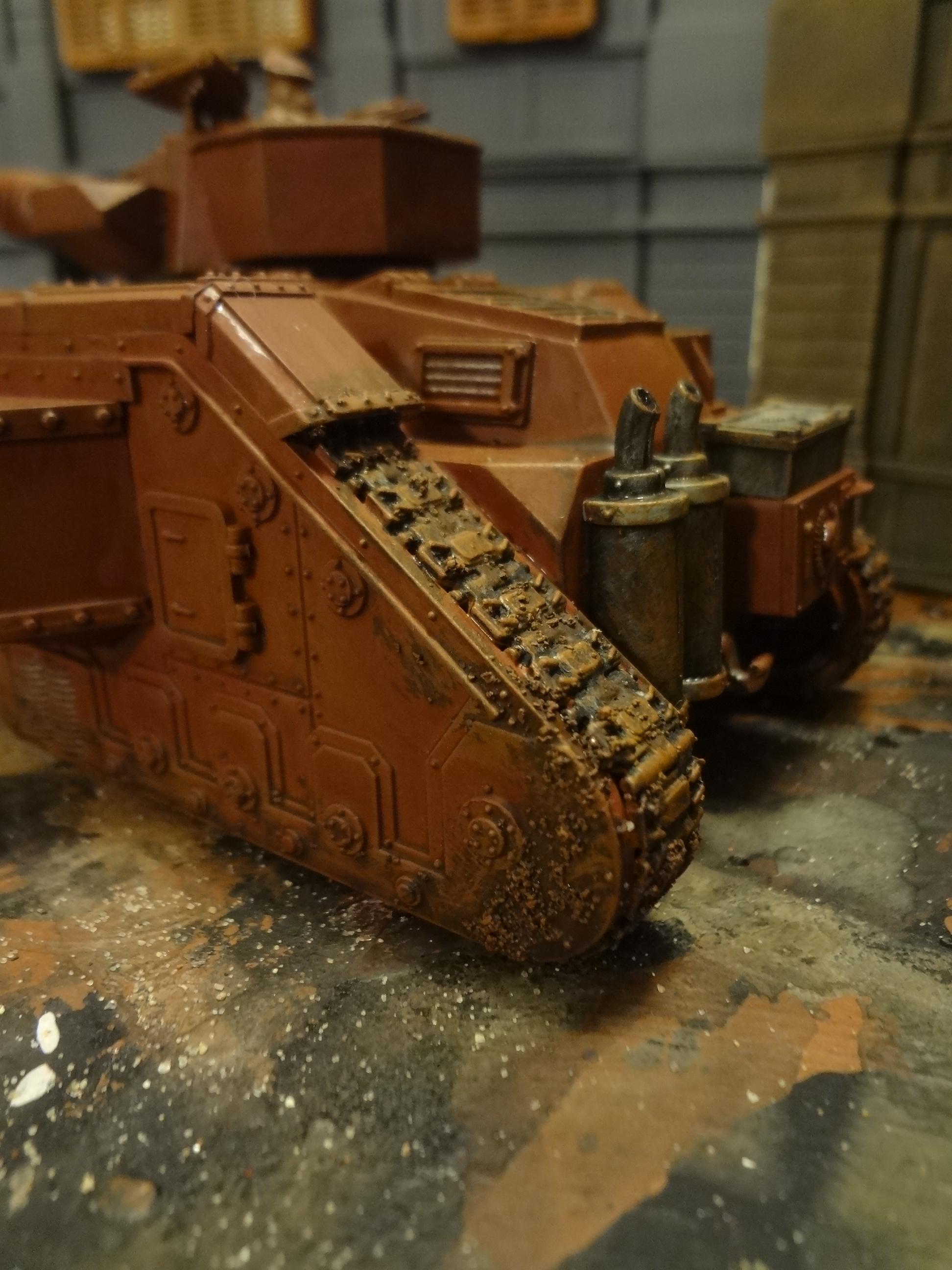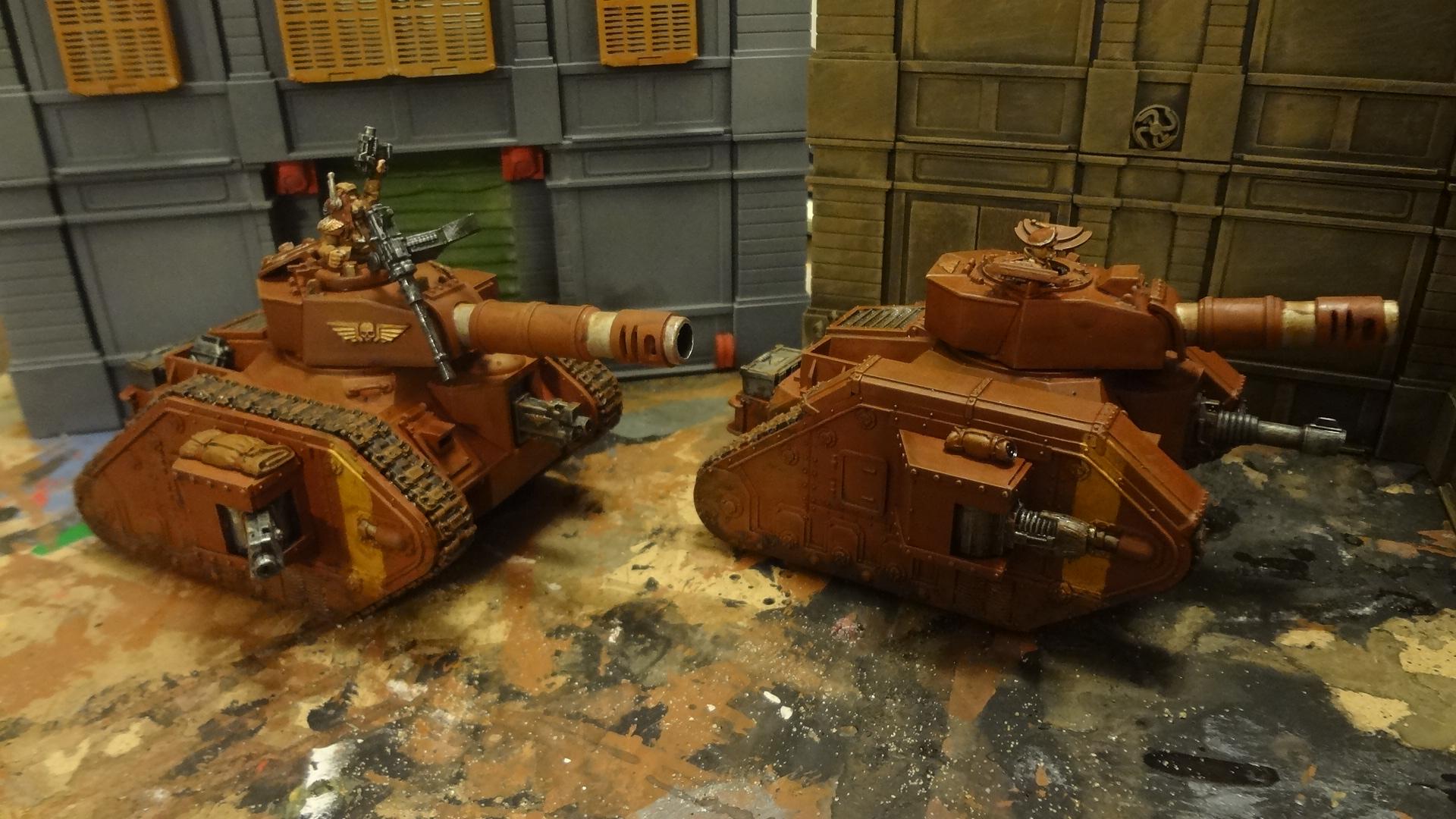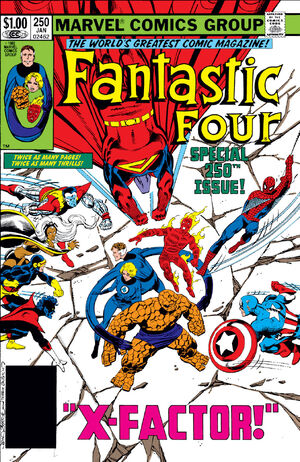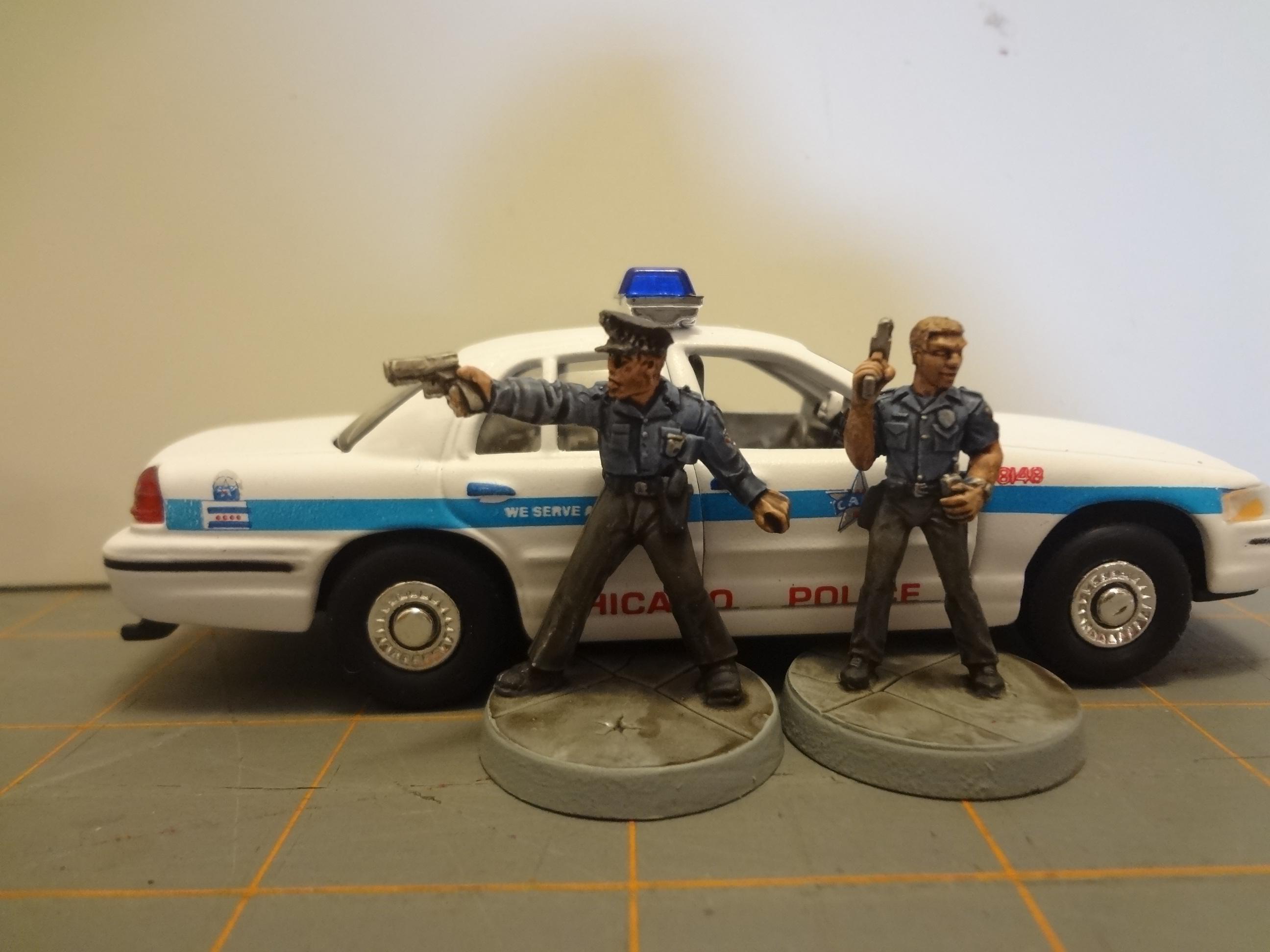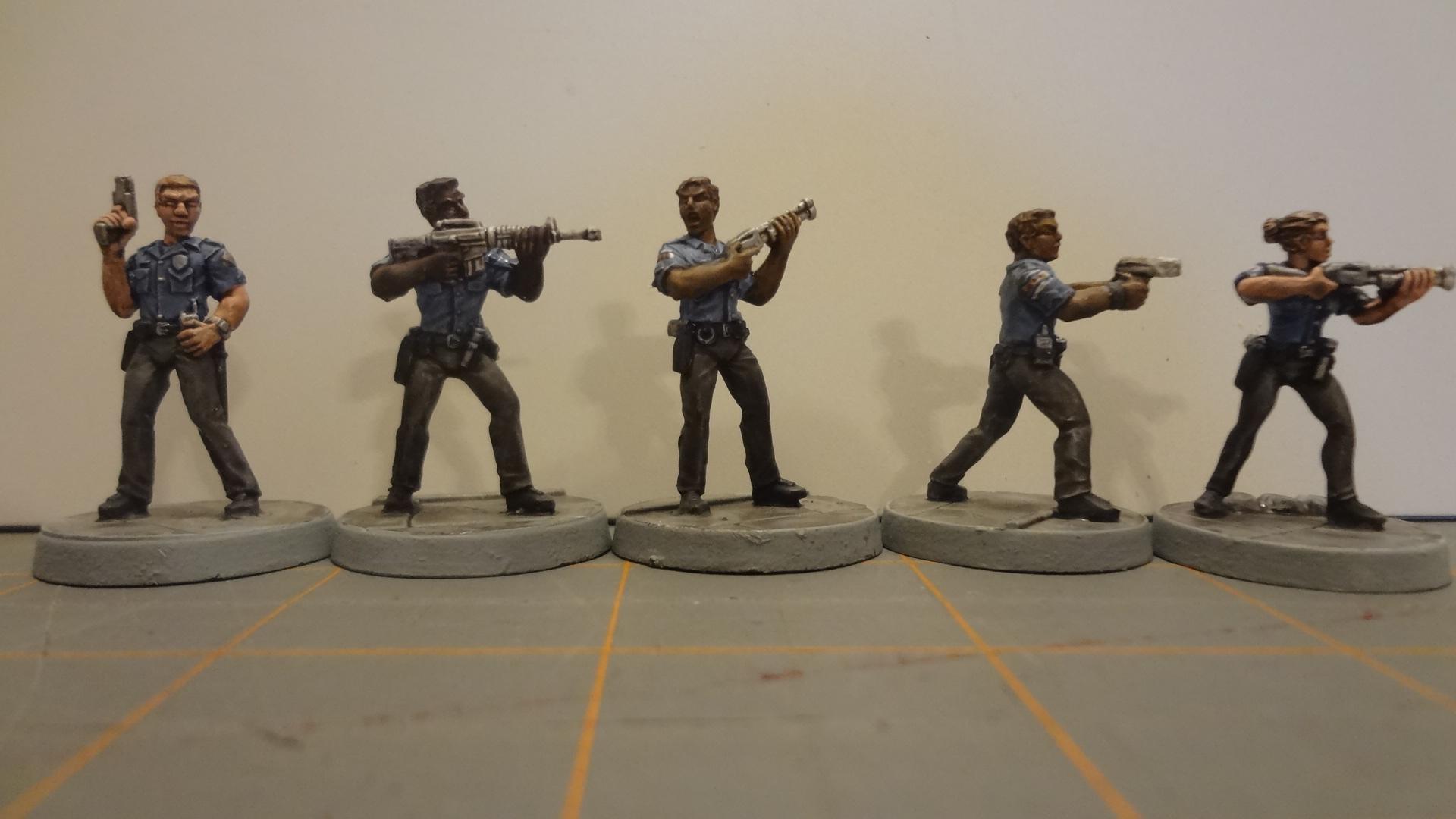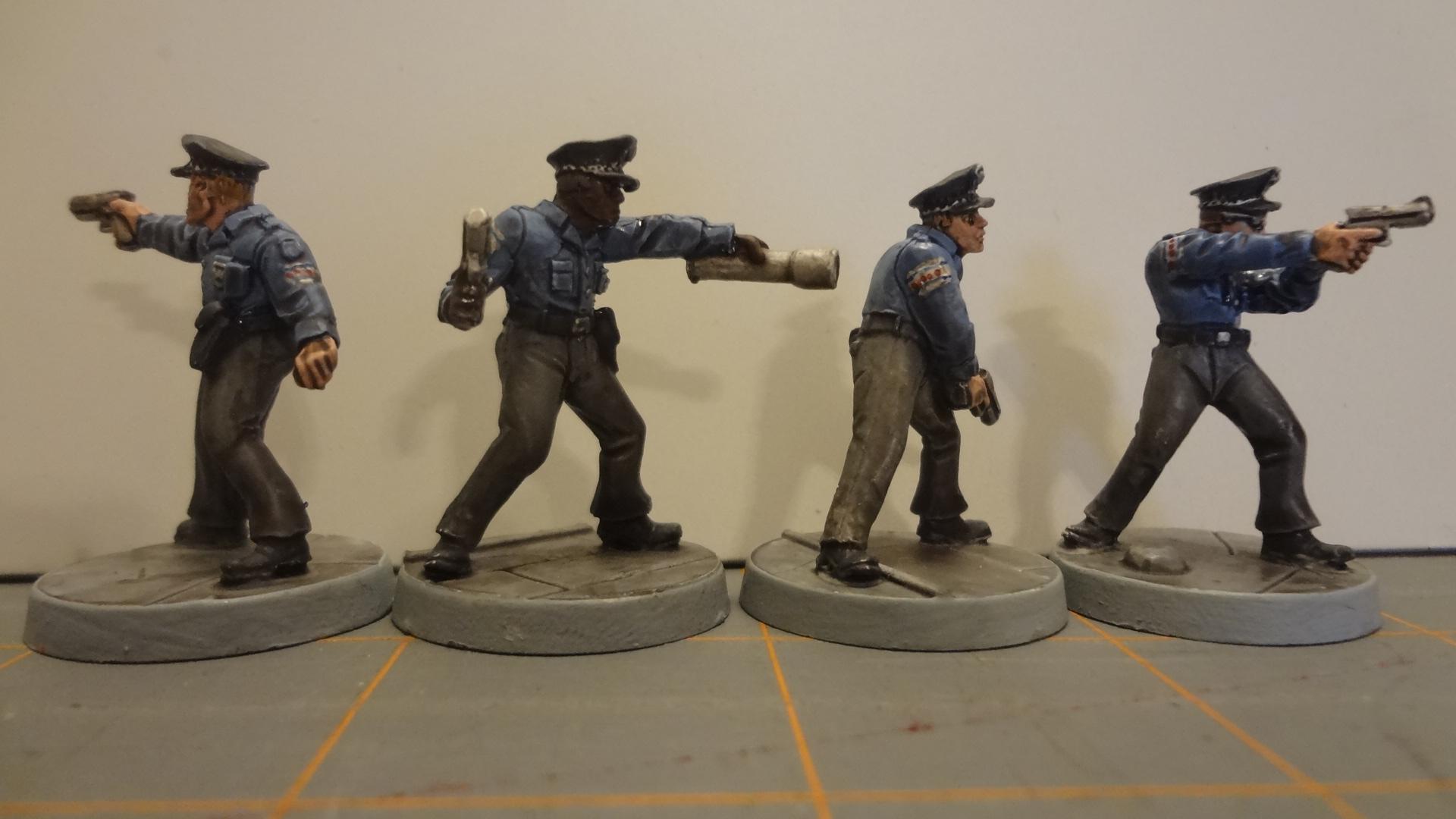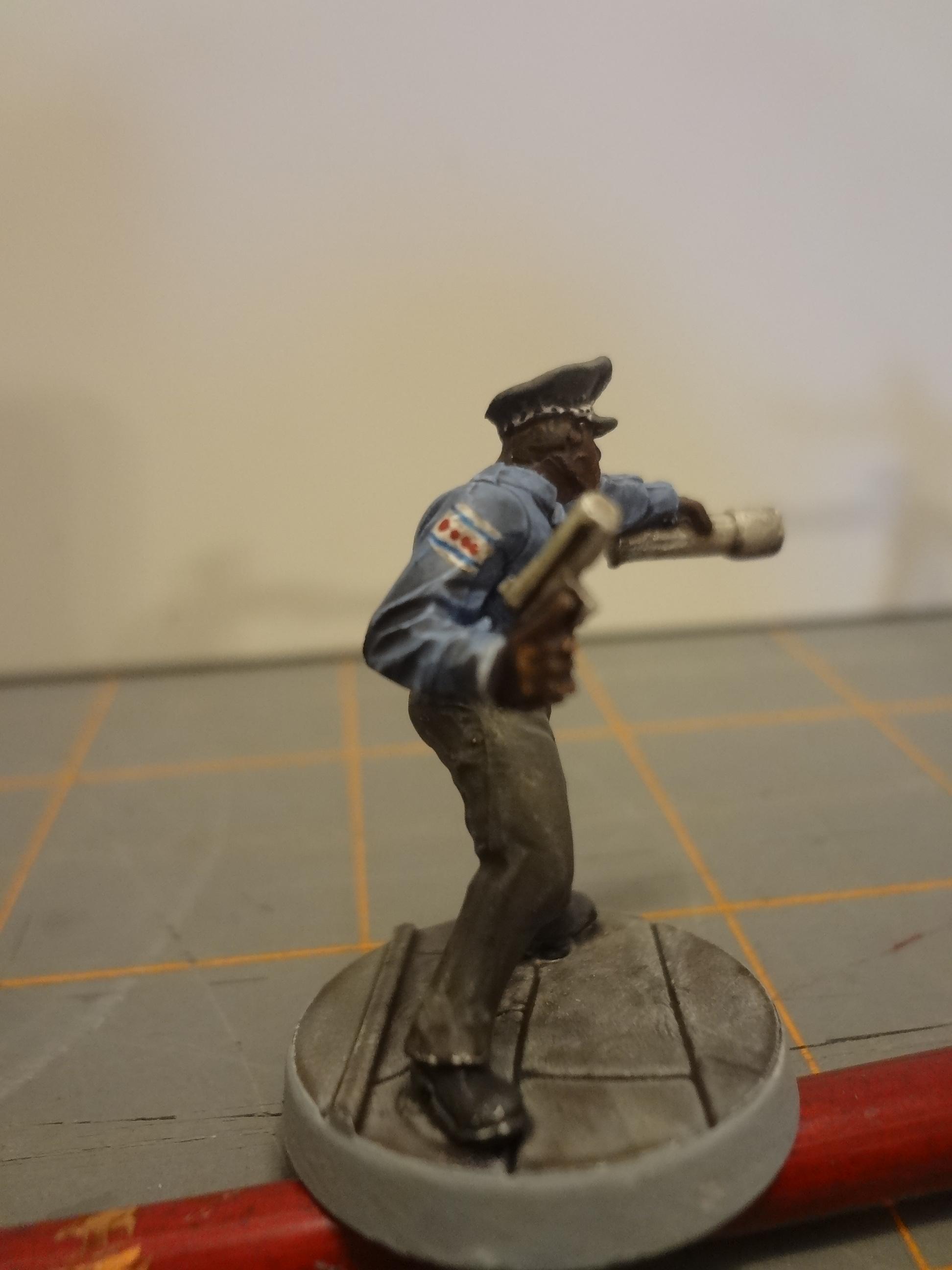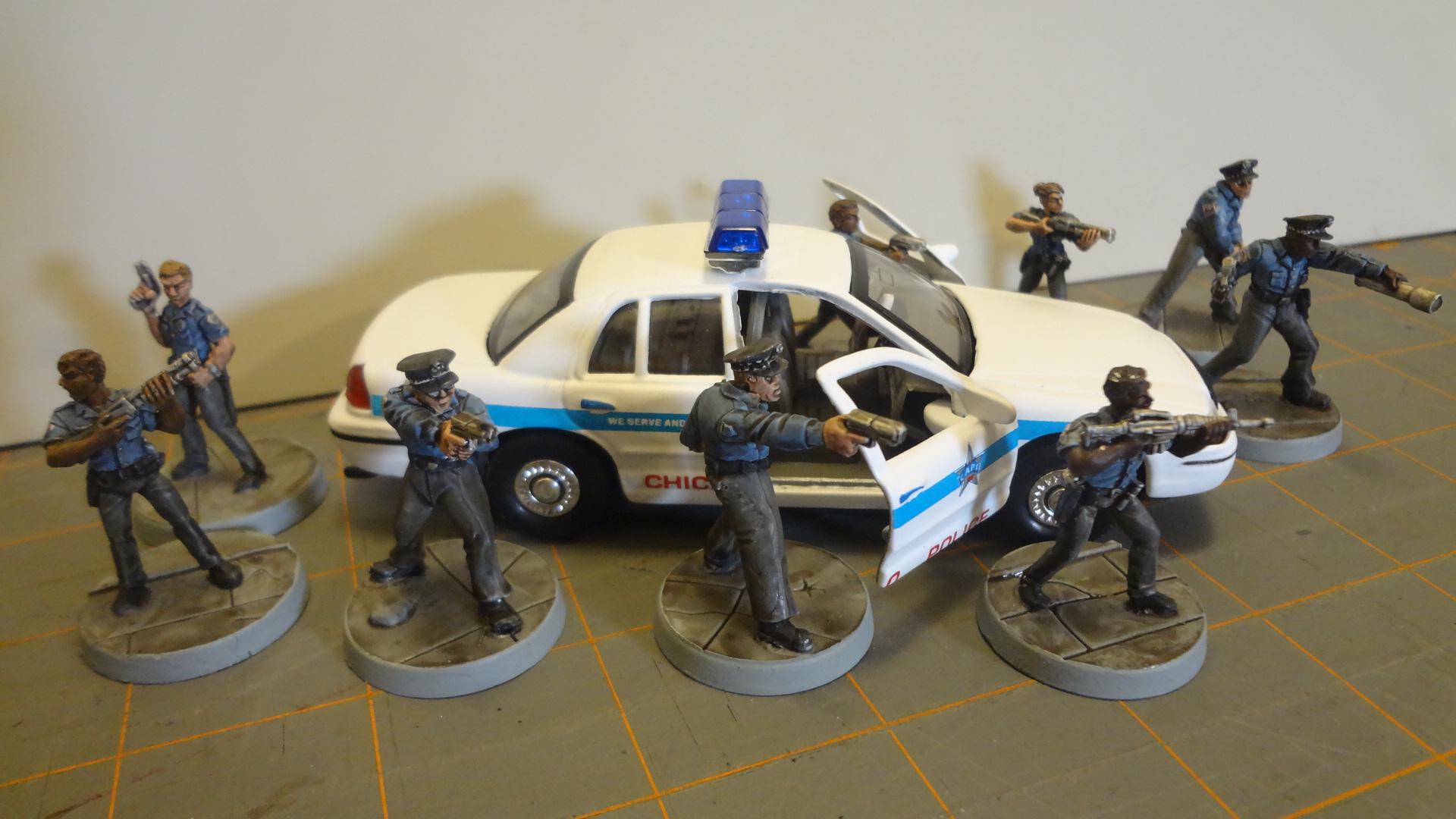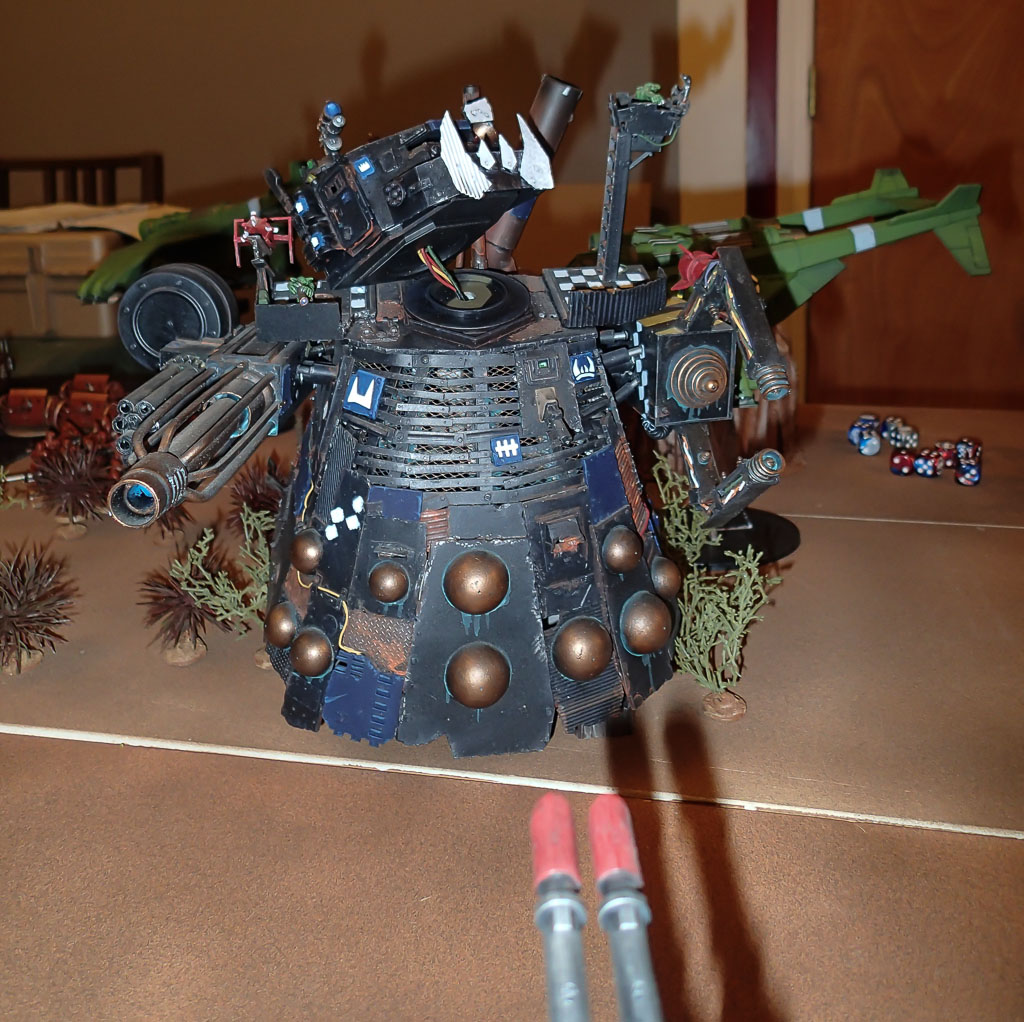Monday, January 12, 2015
Would You Explore These Dark Depths?
Right on schedule, my shipment from 2014's Dwarven Forge Caverns Kickstarter arrived last fall. I participated in the Dungeon Tiles Kickstarter as well, so I was excited to use these new pieces on the table alongside my existing collection.
First, though, I needed a paint scheme. Aside from a few splatters of blood, slime and ooze, my dungeon tiles were mostly monochromatic, as you can see in this pic from a recent game.
That's fine for a dungeon, but the level of sculpting and detail on these cavern pieces begged for a more diverse palette. So I tried added in some bursts of color to the various textures and growths on the cavern walls. Depending on the scenario, these scenic bits can either represent verdant fungi, toxic mold, or even precious gems and ores to be mined and extracted by an enterprising underground expedition.
You be the judge. Would you light a torch and plumb these dark depths?
- Patrick, Chicago Skirmish Wargames club member
Thursday, January 8, 2015
Sedition Wars: A Good Deal for the Patient Modeler
I recently stumbled across one of the biggest bargains in miniatures today: Sedition Wars, Battle for Alabaster. The boxed game can regularly be found for 60% to 70% off, making it a fantastic deal for a box full of Studio McVey miniatures, and oh yeah -- the box also happens to come with a game.
However, as you'll see, I had to overcome a few hurdles to get the most out of these models.
In this review, I'll focus on the Vanguard troopers (the human faction), as I split the box with fellow club member Tim, and he got the other figures.
I have little interest in the game itself, and I plan to use the miniatures as the military forces of the Maersk-Tesla Corporation, a faction in our club's Galactic Frontier homebrew sci-fi setting.
To that end, they have been painted in a scheme similar to my Necromunda Van Saar gang, which also serves double duty as a Maersk-Tesla survey team. I ended up with a number of scenic bases from the Sedition Wars box set, but I set those aside and based up the Vanguard troopers on the same Champ Industries plastic bases as the Van Saar.
The Vangaurd Faction includes 22 models, 17 of which are variations on the basic trooper in four different sculpts.
Here's the male trooper with rifle.
These guys have shoulder joints that protrude much farther back than they should when you attach the arm/gun piece. Rectifying this required shortening the back of the shoulder pad and carving away a bit of the underarm area on the body.
Here is the male trooper with support weapon.
This one went together pretty easily without much trimming. I got two of these figures, both with the gun on the left. The figure on the right is converted with an optional flamethrower bit from my bits box.
Here's the female trooper with helmet and rifle.
The female trooper comes in two poses: one helmeted and one bare-headed. Unfortunately, the connection between right elbow and upper arm is not a perfect one. A bit of sanding to the upper arm helps, but unless you want to sculpt every elbow joint, I recommend a nice thick gel superglue to fill the join. This is annoying, but it looks OK when finished.
Here's the female bare-headed trooper with rifle
The bare-headed female trooper has the same assembly issue as the helmeted trooper.
Here we have a couple female troopers with special weapons.
As well as rifle arms, the female troopers include four special weapons: two plasma guns and two grenade launchers. I wish they had included at least two more rifle arms as an option, but there are no extra guns included. The special weapons arms can be used with the either the helmeted or bare-headed troopers, and both unfortunately have the same elbow issues.
So, the full roster of Vanguard troopers came out as follows.
- 5 males with rifles
- 2 males with heavy weapons
- 5 bare-headed females
- 5 helmeted females
Six of the females have a rifle, and four of the females have a special weapon of some type.
The Bad News
As noted, the joins between the bodies and arm/weapons on most miniatures don't meet exactly. This isn't the end of the world, but I can see how it would be massively frustrating to someone without much gaming experience (Sedition Wars was marketed as a board game, after all). This is a major failing when you consider that most minis consist of just two pieces.
The real kick in the teeth, though, are the mold lines. They aren't huge, but every miniature has them, and they're awkward to remove. Mold lines are an expected part of plastic miniatures, but the issue here is that these figures are made of the sprue-less plastic material (aka restic, plastic-resin, etc) that many companies are using these days to save money.
This plastic cannot be scraped or filed or assembled with plastic solvent glue. All cutting must be done using a sharp knife (use a new blade), superglue is required to attach the pieces. Consequently, the removal of mold lines is a very long and sometimes frustrating task -- far more difficult and time consuming than with resin, metal, or polystyrene.
It took me noticeably longer to clean up a two-piece Vanguard miniature than to to clean-up and assemble a multi-piece Games Workshop infantry model.
The Good News
The sculpts themselves look great. They're a step above any of the other bargain-priced lines of sci-fi troopers. Studio McVey premium sculpts (some of the identical models) will set you back $8 to $15 each when bought individually in metal or resin.
Once properly assembled, these Vanguard troopers look almost as good. The style is crisp, the details are very well done and the design work is great. The figures are an example of the shiny sci-fi aesthetic seen in games like Infinity (where these figures would work as excellent proxies).
For those willing to put in the time and frustration, the opportunity to pick up McVey sculpts for around 50 cents each is too good to pass up.
My Overall Impressions
I really did not enjoy assembling these models, but I can't deny that they look great when done. The crisp sculpting and excellent detail made my speed painting style (block colors and a dip) look pretty darn good.
At this low price, I'm even considering buying another batch just to get more rifle-toting troopers. I might try some head swaps to add a bit of variation.
To be clear, I would never pay the original $90 retail price for this set. At that price, I expect better miniatures with less issues. However, at $25-30 for 50 figs, 50 scenic bases and a playable game, my calculations are completely different.
Sedition Wars: Battle for Alabaster offers the patient and experienced modeler a chance to get great looking figures at a superb price. After I finish a large terrain project, I'll be back with the last five Vanguard minis from this set: four characters and a robot drone.
-- Karl, Chicago Skirmish Wargames club member
Tuesday, January 6, 2015
Armor Reinforcements for Warpath and 40k
I finally brush-dipped and varnished the Leman Russ tanks I painted up for our mega-apocalypse Warpath game from last month. You can read all about it right here.
These vehicles are mostly stock with a couple of modifications, and they received a quick paint job of base colors, drybrush and brush-dip with Minwax Polyshades Tudor. One of these was a kit that I've had sitting around for about a decade and the other is a rescue of a very poorly painted (Testors gloss enamels, ugh) tank I got from Tim.
I lengthened barrel on the this cannon.
And I added a classic metal Imperial Guard tank commander figure -- something I've always wanted to paint one up. Here he is, with a small gas-mask bit from the Imperial Guard command sprue.
This one has a couple of metal plasma cannons from the old Demolisher kit. I'm not sure plasma cannons are an option for standard Leman Russ tanks at the moment, but I'm quite certain I don't care.
The head on the commander is from Pig Iron Productions. Every human figure in my Imperial Guard force has a gas mask.
The mud is Sheetrock brand paint texture mixed into brown paint.
All in all, these were a fun couple of tanks to build and paint.
I can't imagine anyone ponying up the $50 each that Leman Russ tanks cost nowadays, but I've got a soft spot for these ungainly sci-fi-meets-WWI behemoths and was glad to add them to my army.
I don't play 40k anymore, but Warpath is always an inspiration to paint up a unit or two. So, expect the army to continue to slowly grow...I've still got a Valkyrie VTOL, some Ogryns, a small platoon of infantry and a few Chimera transports waiting for the brush.
-- Karl, Chicago Skirmish Wargames club member
Friday, January 2, 2015
Power Legion Game Report: The Fury of Gladiator
Last month the club gathered to try out Power Legion, a skirmish game set in a comic book super world written by Andrea Sfiligoi and published by Ganesha Games. While the game doesn’t have the rights to any of the classic comic book characters, the ruleset can easily recreate those characters.
With my collection of older HeroClix figures, it was easy to pick out some fun sculpts on some older figures of the appropriate characters and rebase them with plastic bases from Proxy Models. (Full disclosure: I am a credited volunteer editor for Power Legion. I was also a serious HeroClix player, so I really like my super heroic games.)
For me, the best part about a game like Power Legion is recreating the battles from classic comic books. There are few comic books more seminal to my love of comics than Fantastic Four #250. Back then when a comic hit a milestone like a 50th or 100th issue, you were in for something special.
Using the stats available online, I created teams for Tim, newcomer Brad, Karl, and me. Tim played (and supplied rebased HeroClix figures for) the Fantastic Four, consisting of Mr. Fantastic, Invisible Girl, The Human Torch, and the Ever Lovin’ Blue-Eyed Thing.
Brad ran the X-Men consisting of Cyclops, Storm, Colossus, and Nightcrawler.
Karl used Gladiator, a super man from a distant galaxy known to the Fantastic Four and the X-Men. I got to play Captain America and Spider-Man.
In Fantastic Four #249, Gladiator arrived on Earth hunting alien Skrulls. Thinking the Skrulls were impersonating the Fantastic Four, he attacked them and quickly defeated them. As the book ends, the X-Men arrived to save the day.
In #250, the X-Men attack Gladiator, drawing Spider-Man and Captain America into the battle. This is where we begin our scenario. Each player was given a secret victory goal.
To battle in downtown New York, you need an urban landscape. For ours, I printed and assembled six buildings, duplicating one, from the Capital City: Base Set PDF from Fat Dragon Games. In Power Legion, each character gets four statistics: Mind, Agility, Strength, and Knockout. (M.A.S.K., see what Andrea did there?).
Each stat is assigned a die: d4 (feeble), d6 (average), d8, d10, d12 and even an occasional d20 for the most powerful characters. In addition, there are pages of powers and abilities that will be familiar to comic book fans and allow players create any hero or villain they might want to play as in the game.
Fans of other Ganesha games will recognize the activation system. One difference is that the player rolls one die (usually a d6 to a d12) with the result giving the character one, two, or three actions to take, while losing their turn on a die result of one. And Ganesha gamers will also recognize the three movement sticks.
Early in the game we realized fliers were fast and cover a lot of terrain quickly. Walkers can take some time to get where they are going, especially if they roll low or miss their activation rolls entirely. That happened early to Tim as the Thing moved into the game slowly.
As the game began, Gladiator swooped from the street to the top of the tower to attack Spider-Man. He must have heard Spider-Man’s crack about his mohawk haircut with his super hearing. The attacker and defender roll their Agility die or some other die if they have certain abilities. Then, if the attacker rolls higher they roll Damage, pitting the attacker’s Strength against the defender’s Knockout.
Gladiator missed his attack and the X-Men went on the offensive. Colossus threw a car at Captain America while Cyclops blasted at the Star-Spangled Avenger, knocking him down to recover on his next turn.
Spider-Man spotted this assault from the heights of the skyscraper and abandoned his battle with Gladiator to help Captain America. When two characters are in melee, whoever rolls higher on the attack then rolls for damage on their opponent. So although Spider-Man was on the offensive, Colossus rolled better for the knockout. And for the trouble he took to come to the aid of Captain America, Spiderman got KOd.
Mr. Fantastic and Human Torch then flew up to face Gladiator. Mr. Fantastic was KO’d on the first shot leaving Torch to face Gladiator alone. But not for long, as Storm blew over from the other building to attack the Gladiator.
Gladiator’s next attack would knock out Storm and the Human Torch with a planned ricochet shot. Storm fell over the side of the building and was revealed to be a Skrull! The X-Men are the fiends Gladiator has been hunting!
Below, Cap and Colossus squared off in a melee that would last the rest of the game. Both were able to hit each other regularly but neither was able to land a telling blow as Colossus’ armored form and Captain America’s shield kept either from being harmed. Even with the protection of the Invisible Girl’s force shield, which eventually got her knocked out by Cyclops, Captain America could not find an advantage over Colossus.
Once Gladiator knew who the Skrulls were, he made quick work of Nightcrawler and eventually knocked out Cyclops when he swooped in for an up-close melee attack rather than trading ranged attacks with the long range marksman.
Colossus continued to square off with Captain America, and it looked grim for the silver skinned Skrull imposter as The Thing moved in. Captain America landed a minor blow that knocked down Colossus, but The Thing was unable to finish him off and the Skrull regained his feet to face off against Captain America and The Thing, then eventually Gladiator as well.
This is when the game devolved into a series of roll-offs as all the characters were landing blows, but none connected for the Knockout. We eventually decided to give the game one more round and on his last attack, Colossus finally took down Captain America.
This meant the Skrulls were able to take down three members of the Fantastic Four (even if it was Gladiator who did their work for them with Mr. Fantastic and the Human Torch) and Gladiator took down three of the Skrull impersonators, leaving Karl and Brad tied for the victory in the scenario.
In Power Legion, when a die roll is modified, it is shifted to the next die type. So a d6 can shift down to a d4 or up to a d8. So, with a second or third action on an activation, it was fairly easy for characters like Nightcrawler or Captain America with the Acrobat trait — gaining a shift from a d10 to a d12 on a melee attck — to make a Power Blow and shift from that d12 to roll a d20 on an attack and hitting successfully. But then they were only rolling a d6 or d8 to deal damage. It made me feel like I was missing some rule or ability that would help that final blow land successfully for damage.
During the game, we found it difficult to damage characters with the Armor trait. Instead of a die shift, Armor adds half the number of sides of the Armor die to a Knockout roll. Collossus with d10 for his Armor added 5 to every Knockout roll. That is an imposing number when the attackers were rolling a Strength die of d8 or d10.
The endgame came down to four characters with Armor, and the combat dragged a bit because of this. Later, Brad suggested a couple of house rules to counter the effect of Armor: 1. If your attack roll doubles your opponents defense roll, you shift your damage die up one level. 2. If your target is prone or somehow disadvantaged, shift your damage die up one level.
During our game, we also never selected any Major Damage effect other than making the opponent make a Knockout roll. A roll on a chart of damage effects, both minor and major, might give the game a little more flavor.
Overall, we enjoyed the game and we look forward to playing again. Of course, it being our first game, we made a few errors. There are also some things that need clarification in the rules. We also left out the Ace Cards and Fate Points that give characters more comic book actions. We wanted to keep thing simple the first time out.
For Karl, not being a superhero gamer before, he figured it would be a good game — it's Ganesha after all — but not one that would interest him much. After the game he really enjoyed it.
"I found the rules pretty easy to learn being in the general vein of Ganesha," he reported. "However there are some very nice changes to the dice mechanics, including the use of the whole range of polyhedrals which I really enjoyed," reported the CSW headman. “I probably won't spend much time painting superhero figs, but it's definitely a game I'd play again and I hope to dig into the rules a bit as they seem to be setup to incorporate the police figures I just finished painting."
We found that multiplayer didn't slow down quite as much as other games we've played, although 2-3 characters per player might be a better roster for beginners.
Look for more Power Legion from CSW in the future. Excelsior!
-- Terrence, Chicago Skirmish Wargames club member
With my collection of older HeroClix figures, it was easy to pick out some fun sculpts on some older figures of the appropriate characters and rebase them with plastic bases from Proxy Models. (Full disclosure: I am a credited volunteer editor for Power Legion. I was also a serious HeroClix player, so I really like my super heroic games.)
For me, the best part about a game like Power Legion is recreating the battles from classic comic books. There are few comic books more seminal to my love of comics than Fantastic Four #250. Back then when a comic hit a milestone like a 50th or 100th issue, you were in for something special.
Using the stats available online, I created teams for Tim, newcomer Brad, Karl, and me. Tim played (and supplied rebased HeroClix figures for) the Fantastic Four, consisting of Mr. Fantastic, Invisible Girl, The Human Torch, and the Ever Lovin’ Blue-Eyed Thing.
Brad ran the X-Men consisting of Cyclops, Storm, Colossus, and Nightcrawler.
Karl used Gladiator, a super man from a distant galaxy known to the Fantastic Four and the X-Men. I got to play Captain America and Spider-Man.
In Fantastic Four #249, Gladiator arrived on Earth hunting alien Skrulls. Thinking the Skrulls were impersonating the Fantastic Four, he attacked them and quickly defeated them. As the book ends, the X-Men arrived to save the day.
In #250, the X-Men attack Gladiator, drawing Spider-Man and Captain America into the battle. This is where we begin our scenario. Each player was given a secret victory goal.
To battle in downtown New York, you need an urban landscape. For ours, I printed and assembled six buildings, duplicating one, from the Capital City: Base Set PDF from Fat Dragon Games. In Power Legion, each character gets four statistics: Mind, Agility, Strength, and Knockout. (M.A.S.K., see what Andrea did there?).
Each stat is assigned a die: d4 (feeble), d6 (average), d8, d10, d12 and even an occasional d20 for the most powerful characters. In addition, there are pages of powers and abilities that will be familiar to comic book fans and allow players create any hero or villain they might want to play as in the game.
Fans of other Ganesha games will recognize the activation system. One difference is that the player rolls one die (usually a d6 to a d12) with the result giving the character one, two, or three actions to take, while losing their turn on a die result of one. And Ganesha gamers will also recognize the three movement sticks.
Early in the game we realized fliers were fast and cover a lot of terrain quickly. Walkers can take some time to get where they are going, especially if they roll low or miss their activation rolls entirely. That happened early to Tim as the Thing moved into the game slowly.
As the game began, Gladiator swooped from the street to the top of the tower to attack Spider-Man. He must have heard Spider-Man’s crack about his mohawk haircut with his super hearing. The attacker and defender roll their Agility die or some other die if they have certain abilities. Then, if the attacker rolls higher they roll Damage, pitting the attacker’s Strength against the defender’s Knockout.
Gladiator missed his attack and the X-Men went on the offensive. Colossus threw a car at Captain America while Cyclops blasted at the Star-Spangled Avenger, knocking him down to recover on his next turn.
Spider-Man spotted this assault from the heights of the skyscraper and abandoned his battle with Gladiator to help Captain America. When two characters are in melee, whoever rolls higher on the attack then rolls for damage on their opponent. So although Spider-Man was on the offensive, Colossus rolled better for the knockout. And for the trouble he took to come to the aid of Captain America, Spiderman got KOd.
Mr. Fantastic and Human Torch then flew up to face Gladiator. Mr. Fantastic was KO’d on the first shot leaving Torch to face Gladiator alone. But not for long, as Storm blew over from the other building to attack the Gladiator.
Gladiator’s next attack would knock out Storm and the Human Torch with a planned ricochet shot. Storm fell over the side of the building and was revealed to be a Skrull! The X-Men are the fiends Gladiator has been hunting!
Below, Cap and Colossus squared off in a melee that would last the rest of the game. Both were able to hit each other regularly but neither was able to land a telling blow as Colossus’ armored form and Captain America’s shield kept either from being harmed. Even with the protection of the Invisible Girl’s force shield, which eventually got her knocked out by Cyclops, Captain America could not find an advantage over Colossus.
Once Gladiator knew who the Skrulls were, he made quick work of Nightcrawler and eventually knocked out Cyclops when he swooped in for an up-close melee attack rather than trading ranged attacks with the long range marksman.
Colossus continued to square off with Captain America, and it looked grim for the silver skinned Skrull imposter as The Thing moved in. Captain America landed a minor blow that knocked down Colossus, but The Thing was unable to finish him off and the Skrull regained his feet to face off against Captain America and The Thing, then eventually Gladiator as well.
This is when the game devolved into a series of roll-offs as all the characters were landing blows, but none connected for the Knockout. We eventually decided to give the game one more round and on his last attack, Colossus finally took down Captain America.
This meant the Skrulls were able to take down three members of the Fantastic Four (even if it was Gladiator who did their work for them with Mr. Fantastic and the Human Torch) and Gladiator took down three of the Skrull impersonators, leaving Karl and Brad tied for the victory in the scenario.
In Power Legion, when a die roll is modified, it is shifted to the next die type. So a d6 can shift down to a d4 or up to a d8. So, with a second or third action on an activation, it was fairly easy for characters like Nightcrawler or Captain America with the Acrobat trait — gaining a shift from a d10 to a d12 on a melee attck — to make a Power Blow and shift from that d12 to roll a d20 on an attack and hitting successfully. But then they were only rolling a d6 or d8 to deal damage. It made me feel like I was missing some rule or ability that would help that final blow land successfully for damage.
During the game, we found it difficult to damage characters with the Armor trait. Instead of a die shift, Armor adds half the number of sides of the Armor die to a Knockout roll. Collossus with d10 for his Armor added 5 to every Knockout roll. That is an imposing number when the attackers were rolling a Strength die of d8 or d10.
The endgame came down to four characters with Armor, and the combat dragged a bit because of this. Later, Brad suggested a couple of house rules to counter the effect of Armor: 1. If your attack roll doubles your opponents defense roll, you shift your damage die up one level. 2. If your target is prone or somehow disadvantaged, shift your damage die up one level.
During our game, we also never selected any Major Damage effect other than making the opponent make a Knockout roll. A roll on a chart of damage effects, both minor and major, might give the game a little more flavor.
Overall, we enjoyed the game and we look forward to playing again. Of course, it being our first game, we made a few errors. There are also some things that need clarification in the rules. We also left out the Ace Cards and Fate Points that give characters more comic book actions. We wanted to keep thing simple the first time out.
For Karl, not being a superhero gamer before, he figured it would be a good game — it's Ganesha after all — but not one that would interest him much. After the game he really enjoyed it.
"I found the rules pretty easy to learn being in the general vein of Ganesha," he reported. "However there are some very nice changes to the dice mechanics, including the use of the whole range of polyhedrals which I really enjoyed," reported the CSW headman. “I probably won't spend much time painting superhero figs, but it's definitely a game I'd play again and I hope to dig into the rules a bit as they seem to be setup to incorporate the police figures I just finished painting."
We found that multiplayer didn't slow down quite as much as other games we've played, although 2-3 characters per player might be a better roster for beginners.
Look for more Power Legion from CSW in the future. Excelsior!
-- Terrence, Chicago Skirmish Wargames club member
Tuesday, December 23, 2014
Chicago Police from Tactical Miniatures and West Wind
Here's another one of those projects that I started long before I had a use for it. I'd been wanting to paint up some Chicago Police Department officers since I picked up four packs of cops at Little Wars for stupid cheap money two years ago. Here's what I ended up with.
- "Rookie Cops" and "Narcotics Team" from Tactical Miniatures, now owned by Armorcast and available here.
- "Police Officers" and "Detectives in Tactical Body Armor" from West Wind, still available direct from West Wind in the UK or from Old Glory in the USA.
I recently painted up the Rookie Cops and Police Officers. First up, I'll discuss the Rookie Cops from Tactical Miniatures.
These guys are very realistically proportioned to the point of maybe being a bit too slender. I ended up with a nice selection of poses and weapons with a modern sculpting style.
And here's a look at the West Wind Police Officers.
These have more of a chunky, mid-90s style to them. They remind me a bit of the Copplestone or Foundry style. They have less fine detail than many current miniatures, and have more of a uniform appearance (no pun intended) with caps, long sleeves and generic semi-auto pistol.
I painted these guys with my usual base colors, a bit of drybrush for the hair and then a brush-dip of Minwax Polyshades Tudor. However, this time I tried something new for me. I painted freehand Chicago flags on all the officers, and checkerboard rims on the caps of the West Wind figures (an essential CPD detail).
I used a micron pen for the black checks and the blue stripes.
It turned out OK -- nothing to write home about, but good for a tabletop-quality paintjob.
These figures are virtually stock, though I cut their slotted tabs down to pegs so I could mount them on plastic bases. I also cut away the insignia on the right shoulders of a couple minis to make space for the Chicago flag.
Speaking of bases, like the Van Saar I painted a couple months ago, I based the cops on Champ Industries plastic scenic bases, in this case the "Urban Design" set.
Though they only come in four styles, the Urban Design set is a nice set of plastic bases depicting broken pavement with some half-buried metal beams. It's very reminiscent of the ancient streetcar and train rails that still show through some Chicago streets.
The bases are slightly bigger than a standard 25mm slotted base (a bit over 26mm in diameter) but you wouldn't notice on the tabletop.
Despite the difference in proportions, I think the two lines will look fine on the tabletop together.
Of course what police force would be complete without some cruisers? I picked up a few of these Welly brand 1/43 Ford Crown Victoria cruisers in Chicago Police Department livery a few years ago.
This vehicle is still a CPD icon even as it's being phased out in favor of smaller Taurus and Explorer based interceptors.
Here's a look at the whole group.
There you have it, a CPD unit ready for action. These figures were a joy to paint and finished up very quickly. I can recommend them without reservations to anyone who needs some cops on their table. I still don't have a concrete use for them yet. They might make their way into next year's Halloween zombie apocalpyse, or perhaps they'll fight alongside superheroes in our next game of Power Legion.
When I paint up the narc team and detectives, I'll have enough variety to make a very cool police force for "Fistful of Kung Fu", a Hong Kong action movie ruleset from Osprey that I recently picked up.
-- Karl, Chicago Skirmish Wargames club member
Monday, December 15, 2014
It's My Birthday And I'll Play Warpath If I Want To
Taking a page from hardball Chicago politics, I used my influence as club organizer earlier this month (and my birthday!) to push for a big game of Warpath in the Warhammer 40,000 universe. We typically play skirmish games here at CSW, but plenty of members have entire legions of 40k figures carefully packed away in foam trays, and this was the perfect excuse to get them all onto the table! Here's how it all went down. (Skip to Parts II and III if you just want the battle.)
Part I. 40k Apocalypse via Warpath 1.0
For those unfamiliar with Warpath 1.0, it is the predecessor to the current Warpath rules, and is essentially the fantasy version of Kings of War with a few sci-fi bits bolted on. Even though they have been supplanted by the current iteration of Warpath, you can download the 1.0 rules for free on Warseer.
The current Warpath 2.0 rules have moved the game beyond simple "Kings of War in Spaaaace!" I still prefer the more streamlined and abstract 1.0 rules, though.
I like giant battles in the Warhammer 40,000 universe, but I don't like the 40k rules. Games Workshop's well-known sci-fi battle game is, in my opinion, a serviceable platoon-level game, good for 25 to 35 figures and a vehicle per player, but over the years it has been unfortunately been scaled up to the company level, resulting in battles featuring 80+ figures and multiple vehicles and without the necessary streamlining of mechanics.
If that weren't enough, over the last three editions 40k has become bogged down with almost RPG-like levels of granularity and complexity, with the addition of layer upon layer of special rules. Even the 40k "Apocalypse" rules for battles at the battalion level don't actually reduce the complexity of the system -- they just pile on more special rules. The result is that a game of "Apocalypse" 40k can take -- no exaggeration here -- a day or more to play out.
Enter Warpath, which -- despite what it's creators will say -- is essentially just a skillfully executed and heavily streamlined version of Warhammer 40k. Most of the army lists for Warpath have direct unit-for-unit analogues in 40k, and even the points values and abilities of the comparable units are similar.
Warpath 1.0 is not supported any more, but the four army lists provide enough stat-lines to represent most 40k units with a little tweaking. Of course, that wasn't going to be quite enough, as we also decided we wanted to have titans and superheavy tanks in our battle.
Jon was brave enough to take this on! Check out his custom rules supplement below.
Part II. Game Setup
Each player was assigned a certain number of points and allowed one superheavy unit beyond that, resulting in about 6,000 points per side. Here is the order of battle (Warpath army list used in parentheses).
Forces of Evil
Forces of the Imperium
We scored the battle based on a combination of enemies killed and objectives seized. Mike's beleaguered Imperial Guard defenders set up in the central complex (fortress, chapel and mining building) in the middle.
The attackers -- me and Jon -- set up on one side and the rescuers -- Josh and Tim -- setup on the other side. This pic shows Mike's Guardsmen in the middle with Tim's rescuing tank company on the way and Jon's rampaging Orks on the other side.
And here we see my traitor Guardsmen invading the city. Pay no attention to the lack of shading on nearest two tanks. I built and painted them for this game and hadn't quite finished them yet…
Josh brought a jaw-dropping 35 Dark Angels Terminators!
Part III. The Game
The first turns were largely uneventful, consisting mostly of movement with some long range firing to and from the Imperial Guard defenders in the center of the field. Like many games, Warpath is designed for a 4x8 foot table, and the ranges reflect this. Our table measured 6x10 feet, so it was some time before the majority of the forces came in range.
The game quickly seemed to separate into the Orks vs Imperial Guard and Traitor Guard vs Dark Angels.
The trio of Rebel Basilisks, however, used their long range and indirect fire to pour devastation into the troops on the tower and would continue to do so for most of the game. With three shots coming down per turn, it was reliably deadly.
By the second turn, Valkyrie gunships swept onto the field, doing some serious damage to the Ork rear guard.
The Dark Angel Nephilim wreaked similar havoc on the Rebel Guardsmen.
By this time, the Imperial Guard armor had presented itself in force and was savaging the Ork line. Mike had wisely included a lot of armor in his Imperial Guard army.
In addition, he skipped most of his infantry options in order to include a Knight Titan. His prudent choices paid off as the combatants drew near.
In the city, the Knight Titan moved close enough to fire on the Dark Angels. Return fire immobilized its legs, but the weapons remained deadly and functional.
In the third turn, two Rebel tanks emerged from reserves. Per the rules in Warpath 1.0, I brought them in on the flank, 36 inches forward (one foot per turn).
By this time, Rebel armor, heavy weapons and walkers were close enough to deal some serious damage to the Dark Angels, destroying several units in a single turn.
On the opposite flank however, the Orks were suffering under the Imperial advance.
The Stompa's head was blown off, and though that didn't destroy the giant war machine, it drastically reduced its effectiveness as the crew struggled to control it.
Concentrated fire from the Imperial Guard armor caused further casualties across the Ork line and to the Traitor Guardsmen holding the center.
At this point we called the game. It was only turn 3, but we had started about an hour late and had run out of time. (Editor's note: It appears Warpath 1.0 gives a complete 40k experience, right down to being unable to finish the game!)
In the end, despite doing serious damage and holding three of the five objectives, the Orks and Traitor Guardsmen came up short to the forces of the Imperium.
Part IV. Observations
Reaction to this game was mixed. Two of us absolutely loved it, two of the players liked it with some reservations, and one player reported that we have other games in our stable capable of giving a better game experience.
Though we only made it to turn three, each player turn took less than 30 minutes, which is not bad for a game featuring three players who had never played before, and two players who had only played a couple of times over the last year.
With more games under our belt, I think we could eliminate most rulebook flipping and cut the playing time nearly in half. One major lesson we learned is the importance of making sure that all players have some anti-armor weapons in their force. Josh's force lacked a way to handle tanks and titans, and it proved to be a major disadvantage. I think this will be solved in the future by changing the heavy weapons selections for some of the vehicles and troops and making use of some of the anti-armor close combat and short-ranged weapons available to many units.
For my part, I really enjoyed the whole experience. It is not a complicated game, but for those times when you just want a massive, somewhat ridiculous battle, it fits the bill. Warpath certainly captures the spirit of 40k: cramming an insane number of troops and vehicles onto a comparatively small battlefield. I have no patience for the 40k rules anymore, but I still have a soft spot in my heart for the minis and the background, and this definitely scratches that itch.
Also, I've still got quite a number of 40k kits in storage, and a game like this is just the excuse I need to get them painted up. All of this is to say: I definitely hope we'll be playing this again. It fits my personal preferences for fun and streamlined rules that don't get in the way of my favorite part of wargaming: the spectacle of painted armies clashing on the tabletop, which drew me and so many others into the hobby years ago. That is something we certainly delivered in this game.
-- Karl, Chicago Skirmish Wargames club member
-- Photos by Josh, Chicago Skirmish Wargames club member
Thanks to Josh for providing the massive central fortress, Jon for providing the Stompa and Warhound, and Mike for bringing a metric ton of tanks to the game.
Part I. 40k Apocalypse via Warpath 1.0
For those unfamiliar with Warpath 1.0, it is the predecessor to the current Warpath rules, and is essentially the fantasy version of Kings of War with a few sci-fi bits bolted on. Even though they have been supplanted by the current iteration of Warpath, you can download the 1.0 rules for free on Warseer.
The current Warpath 2.0 rules have moved the game beyond simple "Kings of War in Spaaaace!" I still prefer the more streamlined and abstract 1.0 rules, though.
I like giant battles in the Warhammer 40,000 universe, but I don't like the 40k rules. Games Workshop's well-known sci-fi battle game is, in my opinion, a serviceable platoon-level game, good for 25 to 35 figures and a vehicle per player, but over the years it has been unfortunately been scaled up to the company level, resulting in battles featuring 80+ figures and multiple vehicles and without the necessary streamlining of mechanics.
If that weren't enough, over the last three editions 40k has become bogged down with almost RPG-like levels of granularity and complexity, with the addition of layer upon layer of special rules. Even the 40k "Apocalypse" rules for battles at the battalion level don't actually reduce the complexity of the system -- they just pile on more special rules. The result is that a game of "Apocalypse" 40k can take -- no exaggeration here -- a day or more to play out.
Enter Warpath, which -- despite what it's creators will say -- is essentially just a skillfully executed and heavily streamlined version of Warhammer 40k. Most of the army lists for Warpath have direct unit-for-unit analogues in 40k, and even the points values and abilities of the comparable units are similar.
Warpath 1.0 is not supported any more, but the four army lists provide enough stat-lines to represent most 40k units with a little tweaking. Of course, that wasn't going to be quite enough, as we also decided we wanted to have titans and superheavy tanks in our battle.
Jon was brave enough to take this on! Check out his custom rules supplement below.
Part II. Game Setup
Each player was assigned a certain number of points and allowed one superheavy unit beyond that, resulting in about 6,000 points per side. Here is the order of battle (Warpath army list used in parentheses).
Forces of Evil
- Karl - 2,500 points of Rebel Imperial Guard (Corporation) and a Wolfhound Titan
- Jon - 2,500 points of Orks (Marauders) and a Stompa
Forces of the Imperium
- Mike - 1,750 Points of Imperial Guard (Corporation) and a Baneblade Superheavy Tank
- Tim - 1,750 Points of Imperial Guard (Corporation) and a Baneblade
- Josh - 2,000 points of Dark Angel Space Marines (Forgefathers)
We scored the battle based on a combination of enemies killed and objectives seized. Mike's beleaguered Imperial Guard defenders set up in the central complex (fortress, chapel and mining building) in the middle.
The attackers -- me and Jon -- set up on one side and the rescuers -- Josh and Tim -- setup on the other side. This pic shows Mike's Guardsmen in the middle with Tim's rescuing tank company on the way and Jon's rampaging Orks on the other side.
And here we see my traitor Guardsmen invading the city. Pay no attention to the lack of shading on nearest two tanks. I built and painted them for this game and hadn't quite finished them yet…
Josh brought a jaw-dropping 35 Dark Angels Terminators!
Part III. The Game
The first turns were largely uneventful, consisting mostly of movement with some long range firing to and from the Imperial Guard defenders in the center of the field. Like many games, Warpath is designed for a 4x8 foot table, and the ranges reflect this. Our table measured 6x10 feet, so it was some time before the majority of the forces came in range.
The game quickly seemed to separate into the Orks vs Imperial Guard and Traitor Guard vs Dark Angels.
The trio of Rebel Basilisks, however, used their long range and indirect fire to pour devastation into the troops on the tower and would continue to do so for most of the game. With three shots coming down per turn, it was reliably deadly.
By the second turn, Valkyrie gunships swept onto the field, doing some serious damage to the Ork rear guard.
The Dark Angel Nephilim wreaked similar havoc on the Rebel Guardsmen.
By this time, the Imperial Guard armor had presented itself in force and was savaging the Ork line. Mike had wisely included a lot of armor in his Imperial Guard army.
In addition, he skipped most of his infantry options in order to include a Knight Titan. His prudent choices paid off as the combatants drew near.
In the city, the Knight Titan moved close enough to fire on the Dark Angels. Return fire immobilized its legs, but the weapons remained deadly and functional.
In the third turn, two Rebel tanks emerged from reserves. Per the rules in Warpath 1.0, I brought them in on the flank, 36 inches forward (one foot per turn).
By this time, Rebel armor, heavy weapons and walkers were close enough to deal some serious damage to the Dark Angels, destroying several units in a single turn.
On the opposite flank however, the Orks were suffering under the Imperial advance.
The Stompa's head was blown off, and though that didn't destroy the giant war machine, it drastically reduced its effectiveness as the crew struggled to control it.
Concentrated fire from the Imperial Guard armor caused further casualties across the Ork line and to the Traitor Guardsmen holding the center.
At this point we called the game. It was only turn 3, but we had started about an hour late and had run out of time. (Editor's note: It appears Warpath 1.0 gives a complete 40k experience, right down to being unable to finish the game!)
In the end, despite doing serious damage and holding three of the five objectives, the Orks and Traitor Guardsmen came up short to the forces of the Imperium.
Part IV. Observations
Reaction to this game was mixed. Two of us absolutely loved it, two of the players liked it with some reservations, and one player reported that we have other games in our stable capable of giving a better game experience.
Though we only made it to turn three, each player turn took less than 30 minutes, which is not bad for a game featuring three players who had never played before, and two players who had only played a couple of times over the last year.
With more games under our belt, I think we could eliminate most rulebook flipping and cut the playing time nearly in half. One major lesson we learned is the importance of making sure that all players have some anti-armor weapons in their force. Josh's force lacked a way to handle tanks and titans, and it proved to be a major disadvantage. I think this will be solved in the future by changing the heavy weapons selections for some of the vehicles and troops and making use of some of the anti-armor close combat and short-ranged weapons available to many units.
For my part, I really enjoyed the whole experience. It is not a complicated game, but for those times when you just want a massive, somewhat ridiculous battle, it fits the bill. Warpath certainly captures the spirit of 40k: cramming an insane number of troops and vehicles onto a comparatively small battlefield. I have no patience for the 40k rules anymore, but I still have a soft spot in my heart for the minis and the background, and this definitely scratches that itch.
Also, I've still got quite a number of 40k kits in storage, and a game like this is just the excuse I need to get them painted up. All of this is to say: I definitely hope we'll be playing this again. It fits my personal preferences for fun and streamlined rules that don't get in the way of my favorite part of wargaming: the spectacle of painted armies clashing on the tabletop, which drew me and so many others into the hobby years ago. That is something we certainly delivered in this game.
-- Karl, Chicago Skirmish Wargames club member
-- Photos by Josh, Chicago Skirmish Wargames club member
Thanks to Josh for providing the massive central fortress, Jon for providing the Stompa and Warhound, and Mike for bringing a metric ton of tanks to the game.



